

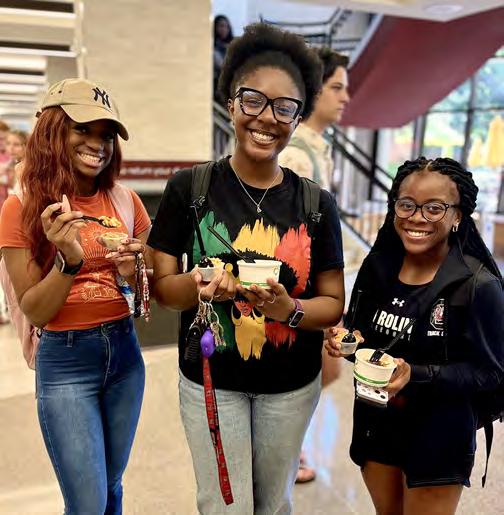
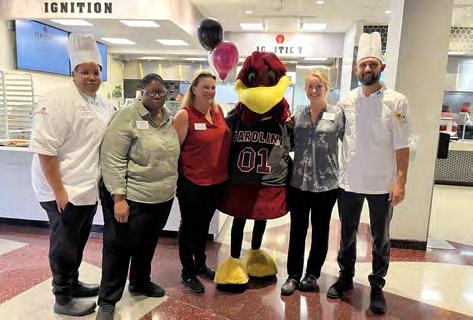

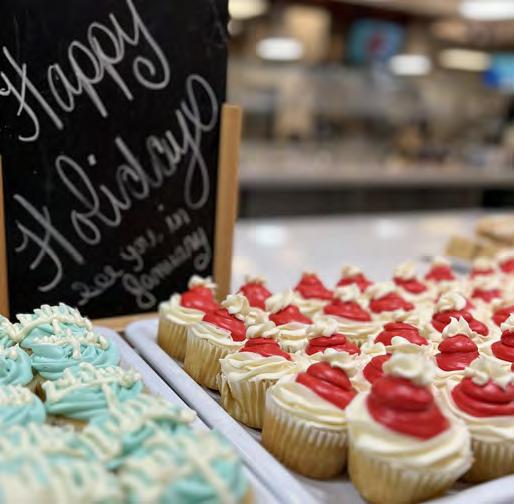




Providing Fresh Culinary Creations for our Gamecocks Every Day!




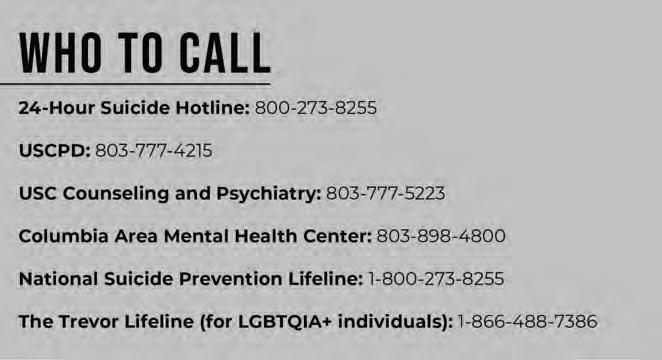
1
Cover Illustration: callie hribar
5
Letter from the editor: Play it back
14
USC students look back on storming field: ‘It was the best night of my life’
23
Next generation of Gamecock women’s basketball players ready to step up, make an impact
32
Column: New bills in South Carolina are femicide, not ‘abortion bans’
41
Column: Students need to budget to get through inflation spike
6
PHOTOS: Gamecock women’s basketball falls in third consecutive Final Four appearance
15
Column: Carolina Core should be major specific
24
Column: 4 bingeworthy shows of 2022-2023 to watch next
33
INFOGRAPHIC: South Carolina sees growing impacts of climate change
43
Club hockey helps bring sport to South with rising social media following
2
650 Lincoln Starbucks honors first Black female student at USC
21
Column: Donald Trump has divided America
13
Column: There needs to be more gun regulation
22
Going to USC is more expensive than 5 years ago
28
PHOTOS: USC leads rivalry game wins against Clemson
31 ‘Sami’s Law’ leaves lasting legacy 4 years after tragedy
40
3 36 Student performers show range in USC theatre’s 20222023 season
theory
role in education; legislation should be examined carefully 44 New leadership of National Pan-Hellenic Council works to ease operations, push representation of organization on campus 45 USC students discuss current, future trends
International student-athletes reflect on college experience in US: ‘It’s the best decision I’ve made so far’ 26
38 Column: Critical race
plays important
25
35
basketball experiences series of highs, lows in first season with Paris
Gamecock men’s
major updates in recent years
break up, future
Campus infrastructure sees
16 Former student band addresses
18 University of South Carolina revives ‘USC’ acronym, changes branding after 4 years
Top university administrators look to further goals after first year at USC 10
leaders give takes on recent, future fashion trends
8
11 Campus
Softball fifth-year players return to continue education, reunite with teammates

4
Letter from the Editor: PLAY IT BACK

Whenever I get bored, or when eduroam isn’t working, I love scrolling through my camera roll.
I think that the pictures are my version of a personal scrapbook, except it doesn’t just include the images that are good enough to print. There are lots of blurry photos and pictures I would never want anyone to see. That camera roll contains photos from my formal right next to screenshots of homework that made me cry.

But being able to scroll past months, semesters and years in a few swipes puts everything in perspective.
The screenshots of slides from class remind me of everything I’ve learned this year and the many things I’ve overcome. The 0.5 pictures bring back memories of spending nights with my friends — talking and laughing until the early hours of the morning.
As the school year comes to an end, I encourage you to look back at your camera roll. Play back those videos of you screaming louder than the music or jumping in the fountain, and remember how USC helped you find your best friends or passion.
For the pictures that may bring bad memories, take them as a reminder of how this year, or the past four years, have helped you grow.
Here’s to adding more pictures to your scrapbook, and all of the incredible things to come.
Gamecocks,
5
photos courtesy of sydney dunlap
illustration: sydney lako
A series of pictures from Sydney Dunlap’s camera roll from 2022-2023. The pictures include a mix of influential and mundane moments from the year.
Sydney Dunlap
Go
Gamecock women’s basketball falls in third consecutive Final Four appearance
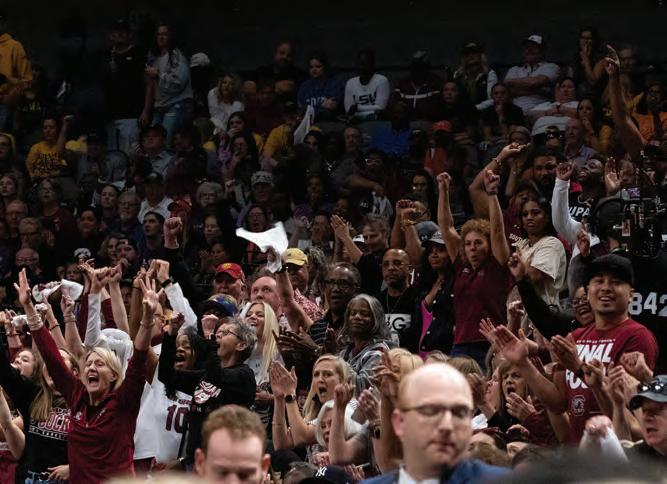

 Sam Schorr
Sam Schorr
The University of South Carolina Gamecocks and the University of Iowa Hawkeyes competed in one of the two semifinal games at the 2023 Women’s Final Four matchup at the American Airlines Center in Dallas, Texas, on March 31, 2023. The Gamecocks fought hard to continue its 42-game winning streak but ultimately fell to the Hawkeyes, led by junior guard Caitlin Clark, who scored 41 points.

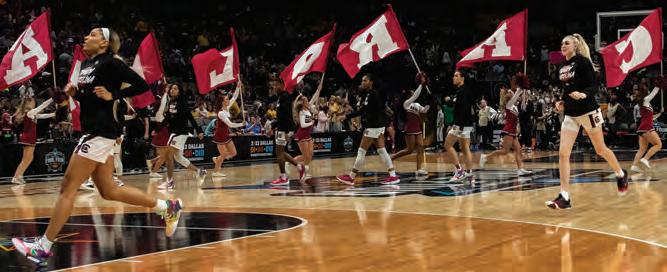
6
The American Airlines Center jumbotron displays the matchup between the University of South Carolina Gamecocks and the University of Iowa Hawkeyes on March 31, 2023. The matchup brought a record number of viewers, with 5.5 million people tuning in to ESPN on average and 6.6 million views at its peak.
Boston, Beal, redshirt freshman guard Raven Johnson, junior center Kamilla Cardoso and Cooke reset after a timeout at the Final Four match against the University of Iowa on March 31, 2023. The Hawkeyes led 22-13 by the end of the first quarter.
Gamecock fans traveled far and wide to cheer on and support their team at the Women’s Final Four match on March 31, 2023, at the American Airlines Center in Dallas, Texas. The crowd cheered throughout the game in hopes of motivating the team.
Senior forward Victaria Saxton wins the tip-off against the University of Iowa at the start of the Final Four match on March 31, 2023. Senior guard Zia Cooke, senior forward Aliyah Boston, senior guard Brea Beal, graduate student guard Kierra Fletcher and Saxton made up the starting five for the Gamecocks.
The Gamecock women’s basketball team storms the court with the South Carolina cheerleading squad for its Final Four match against the University of Iowa on March 31, 2023. At the start of the game, the Gamecocks were 36-0 with a 42-game winning streak.
Cooke steps back and attempts a 3-pointer to decrease the score deficit in the Final Four match against the University of Iowa on March 31, 2023. Cooke led her team, making 18 points and five assists in the first half of the game, and was named the Ann Meyers Drysdale Shooting Guard of the Year.


The South Carolina fan section expresses distress with Iowa being up by 4 points with 35 seconds left in the fourth quarter of the Final Four matchup on March 31, 2023. The Gamecocks managed to get the game within 2 points with 10 seconds left, but the Hawkeyes would secure the win with the help of Clark’s free throws.

Beal prepares to defend Clark at the start of the second half of the Final Four match on March 31, 2023. Beal had significant playing time and defensive work against Clark, who scored for 19 of Iowa’s 38 points in the first half, three of which were 3-pointers.
Clark shoots a 3-pointer on graduate student guard Kierra Fletcher. Clark, the 2023 Naismith Player of the Year, ended the night with 41 points. In her 39 minutes of playtime, she attempted 17 3-pointers and made five.
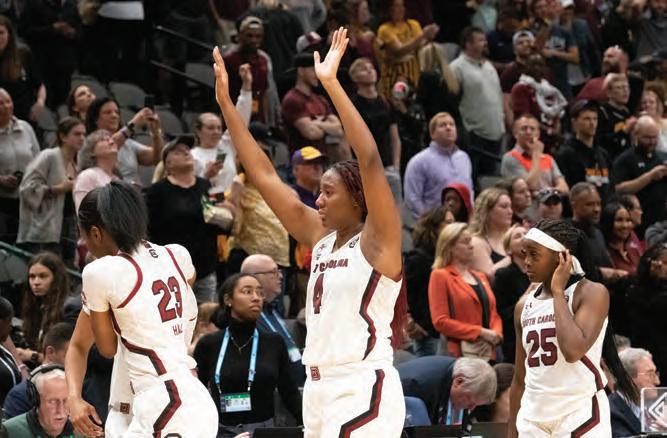
Boston waves goodbye to the Gamecock crowd as she exits the court at the Final Four matchup between the University of South Carolina and the University of Iowa on March 31, 2023. Boston, who had an additional year to play due to the COVID-19 pandemic, would declare for the WNBA draft the next day.
Boston and Johnson share their post-game thoughts about the Women’s Final Four match on March 31, 2023. The Gamecocks lost to the Hawkeyes 77-73, ending its historic 42-game winning streak.



7
Head coach Dawn Staley and the rest of the Gamecock women’s basketball team rises as Johnson hits her first 3-pointer of the night against the University of Iowa at the Final Four match on March 31, 2023. Iowa led 59-55 at the end of the third quarter.
TOP UNIVERSITY ADMINISTRATORS LOOK TO FURTHER GOALS AFTER FIRST YEAR AT USC
emmy ribero
Three top university positions were filled at the beginning of the 2022-2023 academic year — including university President Michael Amiridis, Executive Vice President for Academic Affairs and Provost Donna Arnett and Vice President for Student Affairs and Academic Support Rex Tolliver.

Each administrative leader came to USC looking to accomplish goals such as hearing from students, improving quality of education and transforming mental health services for students.
President Amiridis
When Amridis first began his presidency, he said he came in hoping to organize a summit where USC students could tell him directly what they wanted to see improved.
The summit, Imagine Carolina, was hosted by administration and Student Government to allow students to voice their concerns about the university. From this event, he said his administration created a foundation for its new objectives.
“As the president, I have many more opportunities to interact with the students, to talk to them,” Amiridis said. “What we did with Imagine Carolina also was, for me, it was very exciting, because we had a good number that came and spoke their minds.”
Amiridis said his administration is making progress on areas brought to his attention during Imagine Carolina, citing mental health issues, student advising and parking.
The Division of Student Affairs is restructuring the mental health office and setting up a new model for advising. Additionally, the university is adding two previously privately-owned parking garages.
Moving forward, Amiridis said he plans to reevaluate the administration’s progress and work with Student Government to see if Imagine Carolina can become an annual event.
“We’re not done,” Amiridis said. “We just started in these areas, and we need to address these. I think we need to get their temperatures to see, ‘Is what we believe that we are doing that is positive — does it really make a difference, and are they satisfied by these changes?’”
Provost Arnett
Arnett said her most significant achievement of the year was meeting with faculty and staff in “listening tours” across campus — something she had been planning to do since she arrived at the university.
“I’ve met every department in every college on campus and spent time listening to what they’re most proud of, what their challenges are and met with both faculty and staff,” Arnett said. “And I’ve learned a lot about the richness that is unique to a comprehensive campus like USC.”
Arnett’s initial goals included developing research and providing more high-quality classes for students. Arnett said she plans to progress in this area by hiring people on her team. She recently hired a vice provost of strategy and innovation and is looking for a vice provost and vice president of Global Carolina.
“I’m building the team,” Arnett said. “I’m doing a deep dive in understanding where we need to grow, research and where we have need for academic instruction, so I’m going to be partnering with the president to outline a growth plan for hiring new faculty. He wants to do a large hiring initiative.”
Vice President Tolliver
Coming into USC, Tolliver said he wanted to focus on improving mental health.
Aligning with Amiridis’ goals of restructuring mental health, Tolliver plans to consolidate services by hiring a supervisor in charge of all areas of campus wellness.
In addition to improving mental health services, Tolliver said his highlight of the year is the number of times he has interacted with students.
“That’s the thing that I’ve enjoyed — connecting with the students in their environments,” Tolliver said. “I think it’s important that we understand them, that we see them where they are,” Tolliver said.
To connect with students, Tolliver holds “Tuesdays with Tolliver,” where he immerses himself in student environments to learn and hear from students directly.
During one of his Tuesday sessions, Tolliver said he rode the USC bus for two to three hours
to understand how the transportation system can better benefit students.
“It’s about, ‘How are students interacting and experiencing the services that we’re providing on campus?’ and then, ‘What would they like me to know about those?’ and then what things they would like me to try to either fix, address or enhance,” Tolliver said.
Moving forward, Tolliver wants to continue to play a big role in furthering the university’s goals.
Tolliver’s position touches many different areas in the university, which he believes makes it difficult for him to narrow down what’s most important. However, he said that his main priority is to support the university in its goals.
“Our number one priority is part of the university’s priority,” Tolliver said. “We are already starting to engage in a process to adopt new priorities for the division, and that in turn will guide all the work that we’re over the next
8
photos: Alicia Caracciolo, nickolas hill & courtesy of Kimberley Truett


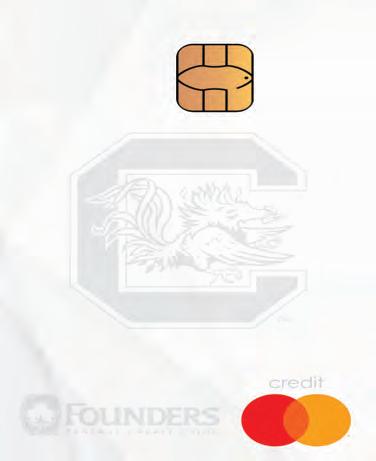


9 Relax TM ... SHOW YOUR GAMECOCK SPIRIT! GET YOUR USC DEBIT CARD AND USC CREDIT CARD1 TODAY! NOT A MEMBER? JOIN FOUNDERS TODAY! All USC students, faculty and staff members are eligible to join Founders Federal Credit Union. See how a Founders Membership can help you up your financial game. Visit our Russell House office or RelaxJoinFounders.com to apply for membership today! foundersfcu.com • 1-800-845-1614 MEMBERSHIP QUALIFICATION REQUIRED. FEDERALLY INSURED BY NCUA. 1You must be 18 years or older to qualify. Qualifications for Founders Credit Cards are based on the Credit Union’s criteria, including applicant’s income and credit history. APRs will vary with the market based on the Prime rate. Rates, terms and conditions are determined by an evaluation of credit history and underwriting factors and are subject to change. MASTERCARD AND THE CIRCLES DESIGN ARE REGISTERED TRADEMARKS OF MASTERCARD INTERNATIONAL INCORPORATED.
Campus infrastructure sees major updates in recent years
caitlin dee
From new dorms to dining improvements to academic building renovations, campus infrastructure has changed in a variety of ways in recent years.
Campus Village
Campus Village, a new development that will include the addition of four residential buildings, is one of the most notable changes.
“There’s four buildings, 1,808 beds. Three of the buildings are suite style,” Derek Gruner, a university architect and the associate vice president of facilities planning, design and construction, said. “One building is traditional, or what I hear people say ‘pod style,’ in which you have a bedroom with two students, but the bathrooms are in the core of the building, and they’re shared.”
Campus Village will have a large dining facility as well as a Starbucks and a sandwich shop, and it will mainly accommodate firstyear students while offering housing to some continuing students.
“We know that freshmen are more successful when they are in suite style and pod style living, and so we purposely created more opportunities for our first-year population down there,” April Barnes, the executive director of university housing, said.
Campus Village has a project budget of $210 million and is set to be finished by the fall of 2023 with no expected delays.

“It’s been a remarkable success. Despite the challenges that the construction industry has faced, that project has really just gone along very smoothly,” Gruner said.
Russell House
Renovations at Russell House, which started in May of 2022, had a budget of $3.8 million and involved installing a new dining hall, Gamecock Park, on the second floor of the building.
“Providing a dining hall that is conveniently located in Russell House was a part of the initial proposal that Carolina Food Co. provided the University when we came to campus in 2017. The campus was in need of a larger, more centrally located dining hall to support the all access meal plan structure that is offered to students,” Faren Alston, the marketing director of Carolina Food Co., said in an email to The Daily Gamecock.
Gamecock Park has also “provided relief to the first floor of Russell House,” according to Alston.
“We are seeing more students dining upstairs in Gamecock Park and Fresh Greene’s which is providing increased speed of service to operations on the first floor,” Alston said.

The new addition to Russell House has received positive feedback from students, according to Alston.
“We constantly solicit feedback from students via our Voice of the Consumer program, surveying, and focus groups. Feedback has been positive in regards to the addition of Gamecock Park. Students really enjoy the flexibility of the all access meal plan and Gamecock Park provides an additional outlet for all access,” Alston said.
That being said, Alston said Russell House is always looking to grow.
“We are always looking for new and innovative ways to bring fresh concepts to campus like the ghost kitchens we are offering out of Food Lab in Russell House. So students will continue to see changes in our offerings to ensure we are meeting the tastes and preferences of our students,” Alston said.
LeConte College
LeConte College, home to the Department of Mathematics, was also renovated starting in May of 2021. The renovations for the building, which was originally built in 1952, involved improving the accessibility of its restrooms by making them bigger and in accordance with modern codes.

The building also had issues involving “water intrusion” due to membrane failure on the roof that needed to be addressed. The roof, which is made of historic slate, also needed to be replaced after the renovations in order to comply with the South Carolina Department of Archives and History.
Renovations on LeConte College were the logical next step Gruner said after methodical updates over the years to all the other buildings in Gibbes Green, the area where the college is located.
“LeConte was just the outlier. It was just the next priority,” Gruner said.
Campus infrastructure will continue to change going forward, with new projects such as the renovation of Longstreet Theatre happening this year.
10
Students grab a meal in Gamecock Park on March 22, 2023. Construction on the new dining hall was complete for fall 2022.
A photo of LeConte College on Greene Street during a cloudy day on March 22, 2023. The university renovated the restrooms and fixed water issues on the roof.
The almost finished construction site of the new Campus Village in front of Bates House and Bates West on March 22, 2023. The living-learning development will be completed in fall 2023.
PHOTOS: Andrew Nguyen
650 Lincoln Starbucks honors first Black female student at USC
Catherine Pruitt
Anewly opened Starbucks on Lincoln Street pays homage to Henrie Monteith Treadwell, the first Black woman to attend USC.

The shop’s interior is decorated with draping floral murals and images of Treadwell, as well as a plaque describing her impact on the USC community.
After applying to USC and being rejected in 1962, Treadwell decided to fight for her opportunity to receive an education, and with the aid of civil rights lawyers, she reapplied to the university and was accepted in 1963. With Robert G. Anderson and James L. Solomon Jr., she became one of “The Three,” a group of Black students who advocated for their right to attend USC and helped desegregate the university.
In 1965, Treadwell completed her degree in biochemistry and was the first Black student to graduate from the university since 1877.
Today, Treadwell serves as the director of community voices at the Morehouse School of Medicine.
To honor Treadwell, developers of the new store reached out to local artist Lauren Andreu and asked her to bring the proposed mural to life. Andreu said she drew inspiration from the floral clothing often worn by Treadwell and from gardens around Columbia to compose the colorful art piece.
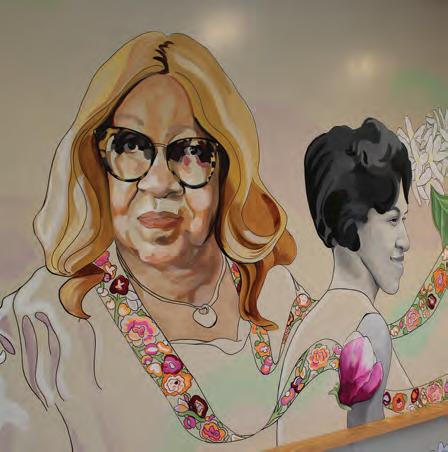
“I think (it’s important) even knowing that this history is actually not that long ago. It’s still alive and well, so I definitely hope that it feels enriching to the experience of people who come through to know a little bit more about the history of the university and this incredible woman who helped trailblaze this path,” Andreu said.
Primo Partners owns the Starbucks franchise and supervised the building plans and opening.
“(Primo Partners is) a Blackowned company, and they promote people of color, all genders, LGBTQIA+, women and put all of those people forward, believing that they’re an underutilized portion of society.
And so they’re very proud of their heritage,”
Stuart Crayk, the store’s assistant manager, said.
Embracing diversity and gender inclusivity has been the fundamental theme throughout the
process of opening the new location, according to Crayk.
Julian Williams, the vice president for Diversity, Equity and Inclusion at USC, said that celebrating diversity is especially relevant today.
“There was a time at this university where not everyone that can attend now, could attend,” Williams said. “I think we have to remember that, especially now, given the current climate as it relates to race, here in this country and in the state, I think it’s important for our students and faculty, staff and community members to remember that time and remember that those individuals are still here.”
As efforts to embrace diversity and inclusion on campus continue, Williams said he feels hopeful for the future of creating a more diverse USC.
“When you walk through campus now, and you see so many faces and cultures and ethnicities represented — that wasn’t always the case here. And it wasn’t that long ago, either,” Williams said. “So I’m excited for us as a university, to think about, ‘How do we honor those individuals past and present? How do we ensure that their legacies still live on? How do we ensure that members of our community currently learn about them?’”
The university plans to continue honoring Treadwell with a new sculpture depicting
“The Three” in front of the Osborne Administration Building by the end of next fall. The work by artist Basil Watson will depict Treadwell, Anderson and Solomon Jr. walking down the stairs at Osborne following their appeals to attend USC.
“She’s an awesome pioneer and represents, in my opinion, what it means to be a Gamecock and what it means to be a USC student or USC graduate alumna,” Williams said. “But also what it means to be a Black woman at that time.”
11
Photos: Nickolas Hill
Top right: The inside of the 650 Lincoln St. Starbucks on March 11, 2023. The Starbucks mural is dedicated to the first Black female student at USC, Henrie Monteith Treadwell.
Bottom left: The front entrance of the 650 Lincoln St. Starbucks on March 11, 2023. The Starbucks contains a mural paying tribute to USC’s first Black female student, Henrie Monteith Treadwell and her impact on the university.



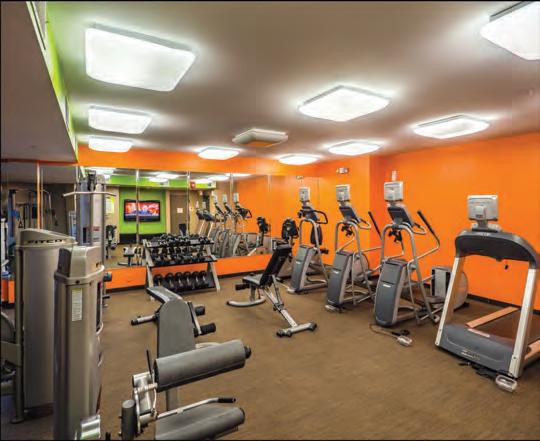




12 with rates as low as $829! come and tour columbia's offc pus BEST HOUSING! SAGACOLUMBIA.COM | 1000 WHALEY ST. | 803.400.1570
There needs to be more gun regulation column:
Gun violence in the United States has gotten out of hand. With the number of deaths due to guns rising every year, this needs to be taken seriously by creating stricter gun laws.
In 2023 alone, there has been a total of 140 mass shootings as of April 5, according to the Gun Violence Archive. A mass shooting in the U.S. is defined as one where four or more people are injured or killed — not including the shooter.







The U.S. has also seen 13 mass murders, which is when three or more people have died in one specified area without a cooling-off period. America has also seen 17 school shootings this year, according to the Washington Post.
This number isn’t something that should be this high. People shouldn’t have to worry about getting shot when they go into the grocery store or learn about math.



America has more guns than anywhere else and the highest rate of homicide by guns in the developed world, according to the Council of Foreign Relations.
“Research across the board, whether you’re looking at it on a national or class national level, or you’re even looking at it as an individual or household level, where there are more guns, there’s more death,” Ashley Mancik, an assistant professor in the Department of Criminology and Criminal Justice, said.
Limiting gun sales or just limiting the type of guns being sold is something that lawmakers need to start thinking about.
These guns are often being bought legally. Ten of the deadliest shootings in the
Julia Goulet
last decade were done with guns that were bought legally, according to ABC News. There needs to be some sort of regulation on buying guns.
There needs to be a background check. Do they have a history of violence or severe mental health problems?

There needs to be a waiting period. The Uvalde shooter bought his guns days before he killed 19 kids.
There needs to be a restriction on what type of gun is being bought. What kind of use does someone have for an AR-15 or AK-47?
shootings jumped to 610, 193 more than the year prior, according to the Gun Violence Archive.
This is after years of being a relatively safe place to be.

“In the bigger picture, we’re so much safer today than we were in the past,” Mancik said. “Now, we’re starting to see numbers that are starting to rise and start to come closer to what we saw in the early 1990s when we were at the peak (of violence).”
Gun violence and the possibility of gun reform need to be talked about seriously. When addressing gun reform, it’s not about getting rid of the second amendment and banning all kinds of guns. It’s restricting the types of guns no one needs and creating a more complete process when buying guns.
People are dying every single day from guns. Kids are going to school plagued with the thought that they might not make
College students were born into this post-Columbine and post-9/11 world, where violence and school shootings are a reality they have to deal with because the people making decisions keep on picking guns over lives.
There needs to be fewer guns in circulation in order to reduce the number of deaths by guns.
“About 50 or 60% or so of all homicides stem from some sort of confrontation or argument,” Mancik said. “(If) you’re carrying a gun and you pull out the gun, you’re more likely going to turn lethal right? So if you sort of remove that from the situation, then as a result, you should see less gun violence.”
In the past couple of years America has seen an upward trend of gun violence. In 2015, there were 383 mass shootings, and ever since then, it’s been rising at a steady rate until the year 2020, when mass
The right to guns shouldn’t mean the right to automatic weapons or to be able to go into a store and leave the same day with a gun.
Guns kill people, and there needs to be legislation that restricts gun sales. If America keeps on with the trend that we’ve seen in the past four years, then it could double the number of mass shootings per year.
Are legislators okay with that? Are they okay with 9-year-olds dying in their classrooms? They shouldn’t be. Call your representatives and call your senators, because if we continue at the rate that we are at, America is in deep trouble.
Infographic: Gillian Thomas
13
USC students look back on storming field: ‘IT WAS THE BEST NIGHT OF MY LIFE’
Second-year sport and entertainment management student Elizabeth Turnage had low expectations when she decided to attend South Carolina football’s last home game of 2022.
Heading into the Nov. 19 matchup against the No. 5 Tennessee Volunteers, the Gamecocks were fresh off of a 38-6 loss to Florida the week before and entered the game as 22.5-point underdogs, according to Caesars Sportsbook.
“I just kind of assumed we were going to lose,” Turnage said. “It was a lot of my friends’ last game, because they were seniors, and they were like, ‘I don’t even care if I go to the game.’”
However, the contest did not end in a Tennessee blowout like Turnage expected and instead saw South Carolina cruise to a 63-38 upset victory.
Griffin Goodwyn
The Daily Gamecock spoke with students across campus about their experiences at the game that night. Nearly all students surveyed said the win and subsequent field storming were among the major highlights of their time at USC.
Despite fans’ grim pregame outlook, students said energy in the stadium started to pick up when the Gamecocks scored a touchdown five minutes into the game.
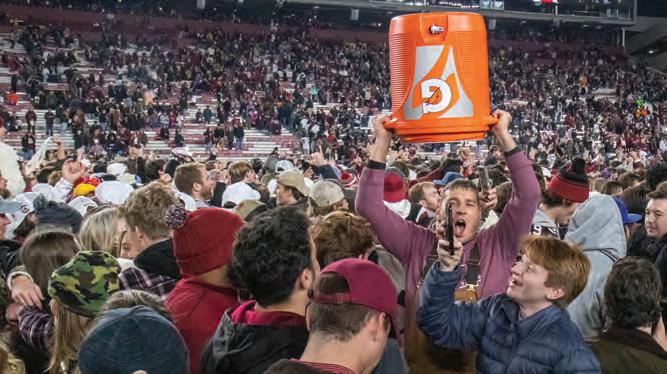
“All the seniors were really sad that everyone was like, ‘Oh, we’re going to get pummeled in our last home game,’ and then all of a sudden we got that first touchdown right out of the gate,” first-year biochemistry student Chesley Blake said. “A lot of the seniors got really emotional, even within those first few minutes.”
As the game went on and momentum continued to shift
further in South Carolina’s direction, fans’ belief in the team continued to grow.
“It’s very easy to become negative, especially when you’re part of the SEC, and you’re playing Georgia, and you’re playing all these tough teams every year,” fourth-year marketing student Yianni Gormanos said. “A lot of people are easy to give up hope, so during that game was the one time that everyone believed we could see this out to the end.”
Evelyn Leary, a second-year biology and psychology student, said the atmosphere differed from other games during the season, describing it as “electric.”
“It didn’t feel like there were 80,000 people, it felt like there were 300,000 people. It was just so much noise, and it felt like everybody was in sync,” Leary said. “Everybody was just so excited it was tangible, almost.”
That excitement ultimately culminated into a swarm of people crowding near the end zone, ready to storm the field once the game was over. According to Blake, the security guards patrolling the student section, recognizing there was no stopping the mass of rowdy fans, eventually moved off to the side before waves of students poured onto the grass.
Once students reached the field, they crowded around the center to take photos, dance, carry each other on their shoulders and grab broken twigs and handfuls of dirt to take with them as mementos of the occasion.
Others, such as secondyear exercise science student Alexander Su, immediately looked for Gamecock football players to celebrate with.
“My first thought was to try and find a player to see if I could get pictures or maybe even a pair of gloves or something, so I got to talk to Luke Doty,” Su said. “I think I took a picture with Rattler, which was cool.”
Even USC students who did not attend the game in person found ways to take part in the celebrations. Third-year international studies student Claire Mattes, who decided to head to Five Points after the game, turned turf from the Williams-Brice Stadium field into a late-night snack.
“I was laughing, and (this guy) put (dirt) in my mouth, and I was like, ‘Oh my God, there’s dirt in my mouth,’ and he goes, ‘We just beat Tennessee. Eat it!,’” Mattes said. “So, I swallowed the dirt and chased it with a Corona, and it ended up being one of the best nights of my life.”
For fourth-year elementary education student Ashley Flint, who tore her pants while storming the field, the football game was particularly special, with it being her last one as a USC student.
“My friends and I were already sad before because, obviously, it was our last one,” Flint said. “But then to win and be able to storm the field for our last game was definitely a way to go out with a bang and something I’ll never forget.”
14
photo: Xavier Martin
A South Carolina fan raises the Gatorade jug used to douse Gamecock head football coach Shane Beamer into the air after the 63-38 upset against Tennessee at WilliamsBrice Stadium on Nov. 19, 2023. Gamecock students and fans rushed the field en masse after the unanticipated win over the Volunteers.
Carolina Core should be major specific column:
Micheal Jacobs III
Carolina Core is an inte part of the academic experience for USC students. However, it could be streamlined by centering on the niche studies of individual students.
Currently, Carolina Core consists of 10 learning outcomes, each with specific credit hour requirements. Eliminating unnecessary general courses from students’ required course load would be a great improvement to this facet of the curriculum.
“I’m a communications major, but why am I taking so many stats classes?” second-year mass communications student Ashley Keaveney said. “I feel like I’m not going to need to use as many as I’m taking so far.”
The streamlining of Carolina Core would require an engineering student, for example, to take science and mathrelated courses only, whereas an English major wouldn’t have the same requirements.
The purpose of Carolina Core is to assist students in acquiring competency in various skill sets outside of their chosen major. This is meant to ensure that students are well-rounded by developing “competency in communication, analytical reason and problem solving, scientific literacy, information literacy and the arts.”

Students are advised to enroll in 15 credit hours each semester to ensure timely progression to graduation. Carolina Core, however, makes the path to graduation much longer than it needs to be, as a minimum of 31 credit hours are required to complete one’s degree.
This aspect of Carolina Core would be greatly improved by major specificity, because this would significantly lessen the number of required credit hours for completion.
Although Carolina Core does offer the benefit of allowing students to explore subjects that aren’t within their specialty — helping them discover new interests — this could also be done by eliminating some of its excesses.
“My roommate is a computer science major,” Cassandra Kueen, a first-year economics student, said. “However, she’s in
a speech class right now, and maybe she’s not going to be doing a lot of public speaking as a computer science major. However, I still feel like it is a skill everyone should have.”
Newly-elected Student Body President Emmie Thompson has proposed the implementation of courses that would help with professional skills, such as financial literacy, that can be added to Carolina Core courses. If Carolina Core was tailored to students’ majors, the course load reduction would provide students with more time to explore courses like these.
With a lightened course load, students’ path to graduation would be expedited and, consequently, less expensive, since students would be at USC for fewer semesters.
By altering Carolina Core to target the majors of the individual student rather than taking classes that may not necessarily benefit students, the college experience could be made less stressful and more efficient. With these benefits in mind, the USC administration should make the change to create a more rewarding experience for the students.
15 1537 Main Street Columbia, SC (803) 779-5001 10% OFF FOR USC STUDENTS CAROLINAHAIRSTUDIOS.COM
Illustration: Gillian Thomas
Former student band addresses break up, future
amanda petty
Over the years, USC has seen many bands form during their time in college. Some, like Hootie & the Blowfish, have experienced major success.
However, not all student bands reach this status. For former student band Bull Street Garage, disagreements led to the group separating shortly after graduation.
The members of Bull Street Garage played together as early as 2020, performing around Columbia and in Charleston and Knoxville. They also released a self-titled album and other singles during their time at USC.

“The highs were high,” Joe DiGregorio, the former guitarist and vocalist, said. “But I think we just need to let our fans and we need to let the greater community know the truth. We need to let them know the truth of what it really looked like playing in Bull Street Garage.”
For DiGregorio, the band’s brand represented five best friends who enjoyed working and playing together. But out of the public eye, former bassist and vocalist Parker Lubin said that conflict grew among the members.
“There was really just a big curtain, and we thought that our individual happiness and pleasure that we got out of playing the shows was more important than the things going on behind the big curtain,” Lubin said.
Behind the “curtain,” the reality of playing in Bull Street Garage was “dangerous” and “violent,” according to Josh Blibaum, the former keyboardist, guitarist and vocalist.
“It wasn’t even brotherly love. It wasn’t like two siblings going at it, it was cold-blooded, and it was just time,” Blibaum said. “Someone would have gotten hurt, and it wasn’t going to be me.”
Blibaum wasn’t the only member impacted, however. Former guitarist Doug Neubauer said his experience in Bull Street Garage soured his relationship with music and caused him to need time away from the band and music as a whole.
“It took a little fun and life out of (playing). Like I said, towards the end, it became a job, so if it’s just doing that, then, well, what’s the point in playing?” Neubauer said. “I guess you just call it work instead.”
Personal grievances and insults ranged from jokes about the others’ height and body odor, to competing ambitions, to stealing girlfriends, to physical fights during practices and on gig stops.
Slights were not solely personal, but also regarded the band’s profits, as one member allegedly stole and profited off of a song written by the others.
The song ‘Mr. Mayhem’ gained popularity in Uzbekistan, according to Blibaum, and because of his ownership, the other members would not receive anything.
“It was a contract that was recognized by all members of the group, saying that I was the sole writer and producer of the song,” Blibaum said. “And for some reason, these guys couldn’t get it through their brains that they don’t make money on a song I own entirely.”
The other members said they would have appreciated the money and are still waiting for a payday. For DiGregorio specifically, he feels that Blibaum deceived them.
“Doug and I wrote that song. And (Blibaum) stole that song from us. Because we signed something we didn’t know what we signed. We did not know what we were signing. We thought that (Blibaum was) going to let us record in (his) makeshift studio at home,” DiGregorio said. “And (Blibaum) Taylor Swift-ed us.”
So, after graduation, the band parted ways, which the members felt was for the best.
“Graduation was the natural way of disbanding it and ultimately brings back to the full circle of ‘Graduation is here. It’s run its course. We’re not going to try to hold this thing together all summer,’” Lubin said.
Now, almost a year after their graduation, the members have continued to reflect and process their experience.
“I think we’re far from healing. I think right now is the moving on, and it feels great,” DiGregorio said. “(I’m) continuing to practice guitar all the time. I think healing is down the road.”
Neubauer said he is still taking time away from music.
“I don’t really touch the guitar too much,” Neubauer said. “Maybe I’ll pick up a different instrument, but for now, I think I need some time off.”
While he may revisit music at a later date, his advice to other aspiring college bands now is to not take things too seriously.
“Try to keep it light, and make sure you have a good sense of humor among each other because we just didn’t,” Neubauer said.
For DiGregorio and the rest of the band, the likelihood of a future Bull Street Garage reunion is small.
“I could never see that happening again,” DiGregorio said. “I think if we got back together, then the album name would be ‘Pigs are Flying in the Sky’ because that would be a sight.”
While they may never play together again, Blibaum said that, despite personal differences, the one thing they always agreed on was their namesake.
“If there’s one thing that stands true in our history, and just on campus and in the world, it’s that big concrete parking structure right in the center of campus,” Blibaum said. “If any part of us has been the capital ‘T’ truth, it’s Bull Street Garage.”
16
Illustration: anna ottinger



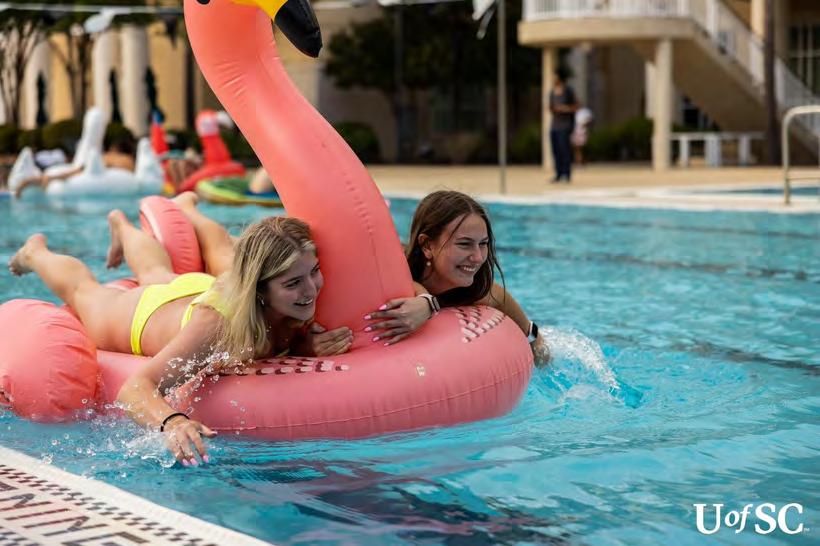




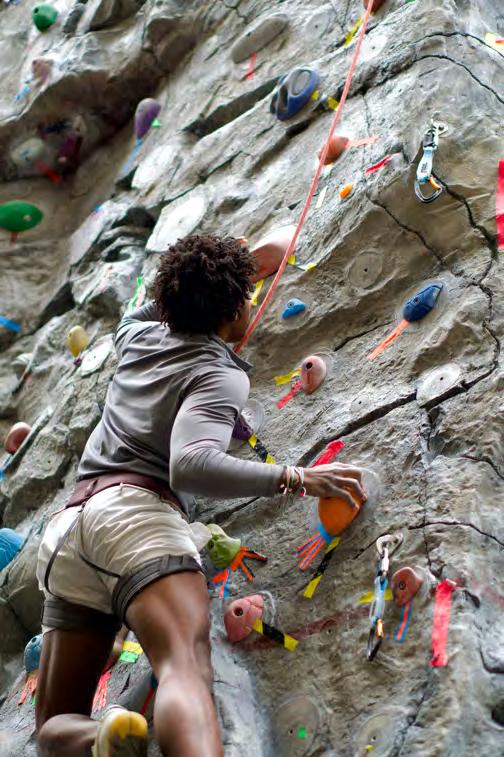





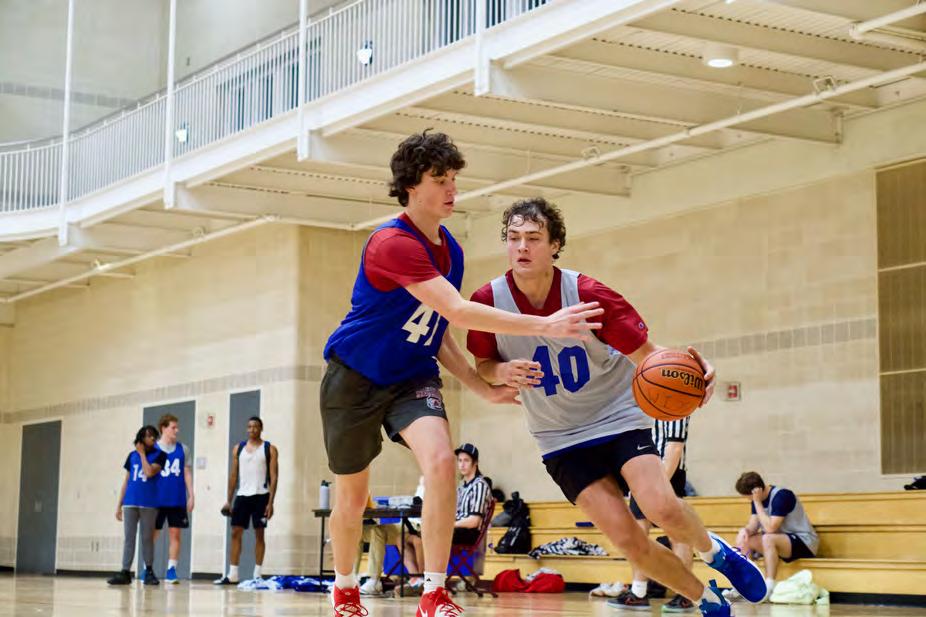










17 @uofsc_campusrec @uofsc_campusrec University of South Carolina Campus Recreation Thanksfora great year! 2022-23
University of South Carolina revives ‘USC’ acronym, changes branding after 4 years
lauren larsen
The university went through its second rebranding in four years, changing the “UofSC” logo mark back to its original “USC” branding in January.

The “UofSC” name was adopted in 2019 to differentiate the university on a national scale. In audiences outside of South Carolina and the Southeast, the University of Southern California is also referred to as “USC.” University spokesperson Jeff Stensland said that for South Carolina, the “USC” name “embodies the university’s longstanding history.”
The brand update includes an updated tree and gate logo in addition to what the university refers to as a USC “spirit mark.” According to Stensland, the change has been well-received by students, faculty and alumni.
Taia McGinnis, a marketing professor at the Darla Moore School of Business and a USC alumna, said by bringing back the acronym, USC has contributed to a newfound sense of pride and spirit throughout campus.
“I think everyone’s always been attached to USC, and so the new logo’s such a reinvention of our old collegiate heritage,” McGinnis said. “It’s just really a callback to what we all feel as alumni, as we all feel about the university.”
According to Stensland, university President Michael Amiridis created a plan to transition back to “USC” when he took over as president.
“It was something that (Amiridis) certainly wanted to accomplish, and he shared that with us before he even officially started here,” Stensland said.
“With the launch of a new brand update, the timing worked really well.”
Stensland said the university changed the name and logo to “UofSC” in 2019 as a way to stand out from other university abbreviations and be easy to search.
Jason Porter, a visual communications professor at the College of Information and
Communications, said that when searching “USC” and “Carolina” on the web, the University of South Carolina never came up, but this changed with “UofSC.”
“It separated us from a search engine (perspective),” Porter said. “Just being able to Google ‘UofSC,’ we’re the only thing that pops up. We own that.”
Despite this, Stensland said many alumni did not adjust
well to the change, believing that UofSC was not representative of their community.
McGinnis said there is a lot of time and energy that goes on behind the scenes in a change like this and that decisions like these are not taken lightly. She believes the changes will make everyone happier.
“Creating a new logo is the most creative part of it, but
18
then the execution of going through campus and updating all the logos, all the print materials,” McGinnis said. “It’s a huge process.”
The university has begun rebranding by creating t-shirts, adding sidewalk adhesives, promoting merchandise giveaways and making digital advances, but social accounts will not change since the University of Southern California has already claimed “USC” in its usernames.
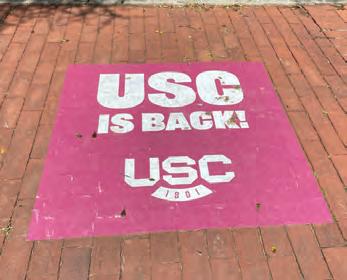
Stensland said the university has used the term “UofSC” on social media accounts long before the university changed its logo to “UofSC” in 2019.

“We don’t see (usernames) as a significant issue,” Stensland
said. “We know that the folks who have followed us on social media for a long time, they’re used to ‘UofSC.’”
From a design perspective, Porter said there are shortcomings of the new logo. According to him, some elements don’t scale down very well, such as the 1801 banner displayed at the bottom.
In his classes, Porter said some of his visual communication students have referred to the design as “generic.” He believes designing a logo could have been a beneficial opportunity for students.
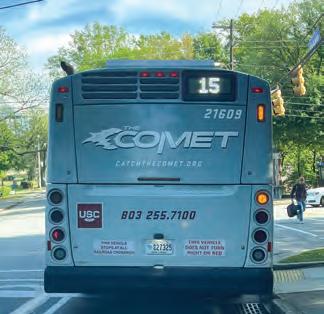
“There are a lot of design students here on campus,” Porter said. “It would have been cool to throw the entire thing at the
students and be like, ‘How would you design it?’ They don’t have to use any of them, but it’d be nice to get student input.”
With the logo being changed twice in recent years, Porter said it is possible the logo could change again.
“It doesn’t feel timeless at all, and there will become a point that something that does not feel timeless is old and dated,” Porter said.
Although time may age the new logo, McGinnis said the USC slogan has created a long-lasting effect on the university, and she hopes the new USC logo will continue to do so for future generations.

Stensland said the university had a challenging past few years
with changes in leadership and the COVID-19 pandemic, but he feels the university is in a very good place now. Moving forward, he hopes alums are satisfied with these changes.
“We hope that it brings a renewed sense of energy, and particularly with alums, and a reason to become reacquainted with the university,” Stensland said.
19
A Comet bus travels through Columbia on March 29, 2023. The bus displays USC’s new spirit mark on the back.
A ground decal in front of the Osbourne Administration building on March 29, 2023. The decal displays the university’s new spirit mark.
A university employee wears a t-shirt with the new USC spirit mark on March 29, 2023. The university announced the new logo on Oct. 26, 2022.
Photos: sydney lako
infographic: sydney lako

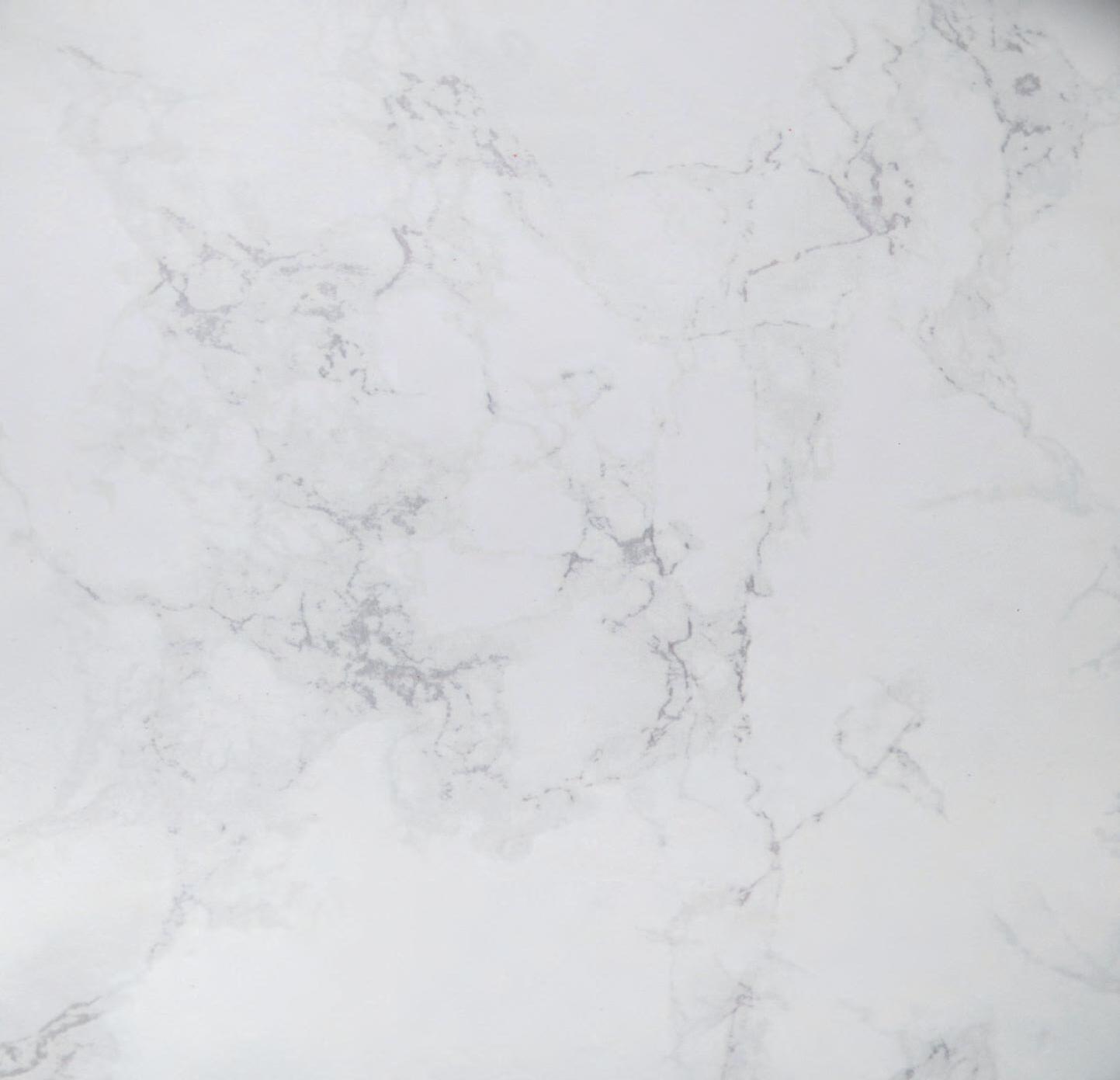






MediaGroup GARNET
WHERE GAMECOCKS FIND THEIR ROOST
for
UofSC email address.
UofSC students post
free when using their
DONALD TRUMP HAS DIVIDED AMERICA column:
Donald Trump’s presidency has created a political climate of deep division, putting marginalized communities in a dangerous position.
It is our responsibility to ensure this type of hate does not continue and to combat the current regressive policies being pushed by politicians, especially the bills being introduced in South Carolina.
While political division wasn’t uncommon prior to 2016, the extent that it has risen is a stark contrast to the campaign culture that came before.
Rates of hate crimes have risen, according to a new report from the FBI. There was an almost 20% increase from 2016 to 2019. In 2019, most of these hate crimes were motivated by race, ethnicity or ancestry.
Trump’s campaign and presidential term felt like a glaring “us vs. them” mentality, one that was different from that of previous presidents. This idea of liberals and immigrants ruining or harming the country gave his voters something to fight against and a hero to root for.
Trump’s success in the polls in 2016 is credited to a selfproclaimed “silent majority,” made up of the middle class or rural white cisgender population. He also boasted a hard stance against immigration and famous lines like “build the wall,” a reference to a border wall between the U.S. and Mexico, which showed his distaste for immigrants.
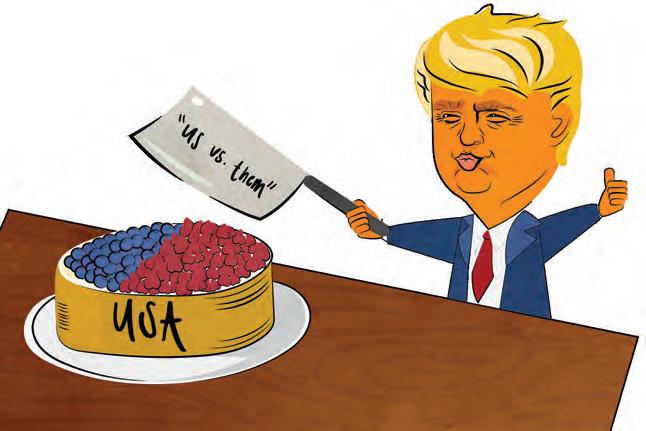
This rhetoric divided the nation, and it was a big division. He also had an incredibly large partisan gap — more than any
bridget frame
other president, according to the Pew Research Center.
Eighty-six percent of Republicans on average approved of Trump’s administration and work, while only 6% of Democrats approved. This gap of partisan approval, being the largest of any president, displays further division. With such a stark partisan contrast, the public has a harder time agreeing with one another, especially over the actions of the president.
While no longer president, Trump still has an extensive influence. An endorsement from Trump can be fruitful for a politician’s career in certain circles, but his disdain for others can have consequences.
Tom Rice, a Republican who formerly represented South Carolina’s 7th congressional district in the U.S. House of Representatives, lost his House seat in Congress during the midterm primaries after voting to impeach Trump for the events on Jan. 6, 2021. Trump then endorsed current member Russell Fry instead to fill Rice’s position.
Trump’s term also has a body count. At a 2017 Unite the Right rally in Charlottesville, a man with anti-Semitic and white nationalist views murdered a woman when driving his car into a crowd of counter-protesters.
Trump was criticized for his response, especially to a situation that he had sown the seeds to create. In his response to the tragedy and violence, he empathized with both sides having bad aspects. This passes blame as opposed to addressing the issue head-on.
This is not what the nation needed to hear after neo-Nazis marched through the streets and murdered someone. There needed to be a unified front against white supremacy, not a response that weakly spread the blame around.
Even after his presidential term, Trump found a way to bring further division. Jan. 6 was a gross display of the nation’s pent up mayhem and people’s estrangement from one another.
It was shocking to have an attack on not only our capital, but our sense of peace and democracy. It led to a loss of life, as seven people died in connection to the attack. It was a signifier of disrespect for our country’s democracy and order.
His shameless encouragement of division and hatefulness has brought about hatred among our population. We can no longer discuss or debate without vitriol for one another, and there is a veil of seeing the “other side” as inhuman.
Trump encouraged this division and egged it on, knowing it served as fuel for his campaign.
a direction to point their anger in,” Thomas Sinclair, the of USC’s College Democrats, said. “Angry people meet other group of
people, other group of people shys away and the divide gets bigger.”
We’ve seen this anger turn towards some of the most vulnerable groups of people in our country. Recently, Tennessee banned public drag shows, and now there are bills in the S.C. Senate to ban gender-affirming care for transgender youth.
There are no winners in a divided country. All it does is further the agenda set by Trump and his supporters on Capitol Hill. It is our responsibility to deny them that satisfaction.
“Both sides need to be willing to sit down and talk. They need to be willing to make compromises, and they have to enter those conversations willing to seriously listen,” Sinclair said.
We need more discussion, rather than hateful action. One can combat this with a gentler treatment of each other. Trump’s entire movement was built off of hate and distrust of one another, so with more kindness and understanding, perhaps we can knit our country back together.
21
illustration: sydney Lako
GOING TO USC IS MORE EXPENSIVE THAN 5 YEARS AGO
Win Hammond
The university calculates on-campus living, including housing, personal costs, books and supplies, to cost a South Carolina resident $34.7K for the 2022-2023 school year. When comparing that to the same calculation in 2017, when an academic year at USC cost $29.3K, expenses have risen 18.4%.
“It sucks,” second-year public health student Laura Witt said. “Higher education should be one of those things that everyone has access to.”
The rise in the cost of attendance is less steep for out-ofstate students living on campus. While five years ago attending USC cost them $49.4K, it now costs about 11% more at $55.9K.
However, economists suggest that, despite the rising cost to attend USC, college is still a worthy investment in the long run.
“It’s clear that tuition has increased quite a bit,” Jason Debacker, an associate professor in the Department of Economics, said. “I think it’s also fairly clear that the college wage premium — the difference between what you earn with and without a college degree — has also increased.”
First-year African American studies student Kanyisile Barrett said that even with in-state tuition, attending USC is pricey, but she sees her degree as a necessary step towards getting her doctorate.
Rising costs and inflation have made college attendance more expensive than it was five years ago, despite four years of tuition freezes.
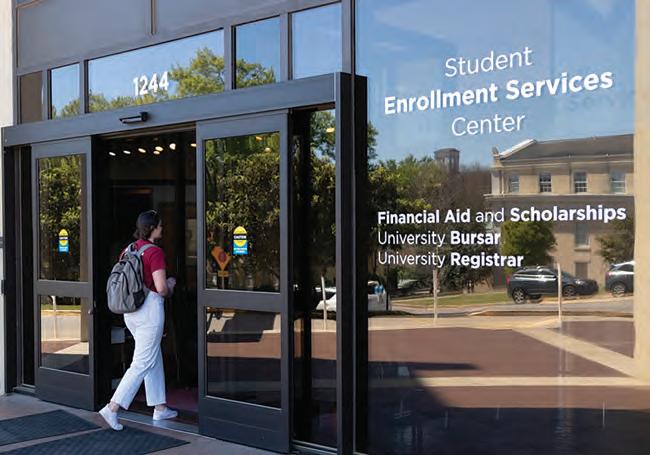
Rising cost of attendance — which includes tuition, tech fees, average housing costs and food — has been a trend since the 1970s, but USC, Columbia and economic policy have all changed since South Carolina approved the first tuition freeze for the USC system four years ago. The war in Ukraine and COVID-19 are two factors that have shocked supply chains and in part cost USC students and Americans money.
However, housing is often the biggest cost for not just USC students but all Americans. Since August 2017, the consumer price index for the average price of rent has risen by more than 82 points according to the Federal Reserve Bank of St. Louis. This means rent has inflated by 26% across America in a little over five years.
“The global pandemic has led to prolonged budget uncertainty for many South Carolina families,” former Interim President Harris Pastides said in a 2021 press release about USC freezing tuition. “I hope that we can give some comfort to both current and future students that we recognize these challenges and that our institution is committed to offering affordable degree programs.”
“It definitely should be a lot cheaper to come here,” Barrett said. “Higher education is needed essentially to have any good job in this country and if you want to make real money.”
Earning a bachelor’s degree today gives a college graduate a better chance at earning a higher wage than it would over 30 years ago, according to the Federal Reserve Bank of Cleveland. However, job opportunities for workers with a bachelor’s degree have become more competitive as more Americans earn a college diploma. According to the Education Data Initiative, more than 50,000 more students graduated college with a bachelor’s degree in 2020 than in 2018.
Orgul Ozturk, a professor and the department chair of economics, said getting a college degree — and hopefully higher pay — isn’t just about passing your classes and extracurriculars.
“I don’t think it was ever itself enough — having a diploma,” Ozturk said. “It was what was included in that diploma.”
Seniors, or soon-to-be graduates, may have to compete with other workers with a newly acquired bachelor’s degree, but Ozturk said the investment and accessibility of a higher degree is still a good thing. From 2000 to 2016, over 10% more high school graduates from low-income families have enrolled in four-year institutions.
“It’s not about the quality of education or anything, it’s about accessibility of college education,” Ozturk said. “It’s not accessible by everyone, but (it’s) accessible by more.”
22
Fourth-year international business student Sarah Cowman walks into the Student Enrollment Services Center on March 21, 2023. The building, which sits on the corner of Blossom and Sumter Street, houses the Office of Student Financial Aid and Scholarships, the University Bursar’s Office and the Office of the University Registrar, which are the offices in charge of taking care of student financial obligations.
Photo: Sam Lowry
Next generation of Gamecock women’s basketball players ready to step up, make an impact
Emma Edwards
Players from the No. 1 women’s college basketball recruiting class for the 20192020 season will soon step away from the spotlight and pass the mantle to the next generation of players.
The class that calls themselves the “Freshies” boasts an impressive resume, losing only one home game in their four years at Colonial Life Arena while maintaining a 130-7 overall record.
The outgoing senior class, which includes forwards Aliyah Boston and Laeticia Amihere along with guards Olivia Thompson, Brea Beal and Zia Cooke, has left behind a legacy that will influence the program for years to come, according to head coach Dawn Staley.

“They came in with a certain following and with a lot of publicity, and they just wanted to be understudies to what was already here,” Staley said. “They took on that role and have taken our program to another level from a cultural standpoint.”
Staley and the team, however, said there will be a considerable gap to fill in the absence of their powerful senior leadership and experience for upcoming seasons. South Carolina’s new, promising group of young players — including sophomore forward Sania Feagin, freshman forward Ashlyn Watkins and redshirt freshman guard Raven Johnson — are ready to continue the legacy of the

“The younger players really understand the high standard, and play, and practice, and community service and just treating everyone with respect,” Staley said. “They really have an understanding of how you have to approach that every single day.”
Feagin saw opportunities for playing time this season as a means to improve her dominance and defensive skills, which Staley deemed the “hardest learning curve” for her.
Staley said Feagin’s commitment to the game has increased since her first year with the Gamecocks. She said Feagin has come to understand that domination is a process that she must go through, just as Boston did, to get to the top of the game.
Watkins saw an average of almost 11 minutes a game this season, averaging 4.9 points. Playing in 32 games in just her first year, she stands out as another upcoming star for the Gamecocks.

“I feel like I have proven myself to play more, and I know that we have a lot of great people on our team and that I am not going to get as many minutes as I want to as a freshman,” Watkins said. “But I know that I have to work hard for the minutes that I want.”
Many of the younger players came in with a willingness to sit back and learn from their veterans, but according to Feagin, they are ready to showcase their talents when the time comes.
“Coach always says, ‘No matter what, when your number is called, be ready to go out there and do what you know how to do,’” Feagin said. “I just felt like I went out there and (did) what I know how to do”.
Staley said their efforts in practice have been one of the biggest areas of growth for the younger class from day one of the season.
“They are ready. If we needed them to substitute in, I feel very
comfortable,” Staley said. “It would be different but equally as effective.”
One of those opportunities to play significant minutes came in the first round of the 2023 NCAA tournament.
Players such as Feagin, Watkins and Johnson all made an impact on the game. Johnson, in particular, showcased the depth of the Gamecocks’ offense, tying her career-high seven assists with four coming in the second half of the game against Norfolk State.
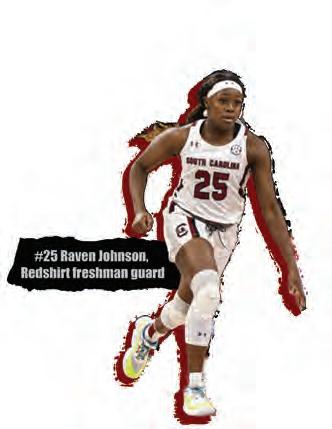
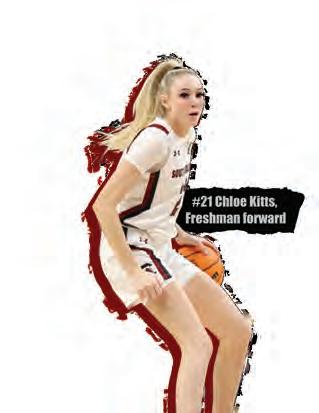

“I just tried to get them in the game with some of our older players just to give them some experience,” Staley said. “I would like for some of our young post players to really get some experience playing in big games and having to be counted on.”
The “Freshies” have already established themselves as one of the most impressive recruiting classes in the history of the sport, and their legacy will impact the program and the players for years to come.
“This entire class deserves to be lifted up,” Staley said. “They are deserving of something — of us really celebrating them and what they’ve meant to our program, to our university, to the city of Columbia and the state of South Carolina.”
23
photos: nola Dixon, Taylor Kitchens & Xavier Martin
illustration: Ava Andrews
4 binge-worthy shows of 2022-2023 to watch next column: ali mullendore
This year was a stellar time for television. With the premiere of brand new series, adaptations and notable seasons, TV lovers will remember these blockbuster hits for years to come.
With classes coming to an end, students will have more time and energy to binge the shows they were too busy to watch during the academic year. Here are the four best series from this year that you should add to your watchlist.
“The Last of Us”
Arguably one of the best video game adaptations to date, HBO’s “The Last of Us” series follows the story of an unlikely pairing as they navigate a treacherous, postapocalyptic world. The outbreak of the contagious Cordyceps disease causes infected individuals to turn into zombielike creatures, creating action and suspense with every scene. In real life, this infection is present only among insects, but this show forces viewers to ponder the harrowing idea of the virus manifesting in human form.
With the narrative mostly paralleling the plotline of Naughty Dog’s video game, “The Last of Us,” the story of the two protagonists, Joel and Ellie, presents themes of heartbreak, sacrifice and humanity during a tragedy.
The series has garnered over 6.4 million viewers since its release in mid-January, and while the show can certainly stand alone, game lovers will appreciate the tasteful details included throughout the series that pay tribute to the original story. Superb acting performances, a beautiful storyline and gutwrenching twists around every corner make this show an emotional masterpiece.
Almost every scene in “The Last of Us” keeps viewers’ eyes glued to the screen as they wait to see what will happen next. The show has managed to reach a level of viewer-character connection that is seldom seen on television, making it a unique example of the power of meaningful storytelling.
“The White Lotus” — Season Two

If you can get past the creepy, yet oddly catchy intro music, HBO’s “The White Lotus” is one of television’s most clever social satires. While the first season tackled themes of socioeconomic and racial disparities, this new season focused on relationships, love and sex — all within the beautiful landscape of a Sicilian paradise and under the guise of crude humor.
Besides the return of Jennifer Coolidge’s beloved character, Tanya McQuoid-Hunt, season two featured both a new setting and a revamped cast, with big names like Theo James and Aubrey Plaza joining the show. This new atmosphere proved to be successful, as more than 70% of fans on Rotten Tomatoes gave the season a positive review.
Each character’s overlapping, welldeveloped storylines are what give this show its distinctive flair. From the uncomfortable dynamic between two college best friends to the Di Grasso men and their generational issues with women, this show spends just the right amount of time developing each story. The plot is so rich that it is easy to forget that the show is actually a murder mystery at its core.
The shocking reveal of the deceased and the killer is sure to leave viewers’ jaws on the floor as they eagerly await the premiere of the next installment. The compelling acting performances and clever storytelling make this show an unforgettable watch.
“House of the Dragon”
Following the disappointing conclusion to the “Game of Thrones” series, fans were curious about the new spinoff series, “House of the Dragon.” Luckily, this show learned from past mistakes and returned the “Game of Thrones” series back to its roots as one of the best on television.

The story follows the Targaryen family approximately 200 years before the events of “Game of Thrones,” answering viewers’ questions about the family’s origin story and ultimate demise.
The main plotline follows a young princess, Rhaenyra Targaryen, who fights for her place on the Iron Throne against her male counterparts. Through a journey of betrayal, confounding love affairs and dragon fights, this prequel series was equal parts captivating and jaw-dropping. Superb performances by the actors are enough to put “House of the Dragon” on this list, but the rich storylines and the typical, elevated “Game of Thrones” production quality are even more reasons to watch this thrilling revival.
“1923”

The “Yellowstone” franchise has taken the television world by storm via the original “Yellowstone” series (2018-present) and its prequels, “1883” (2021) and “1923” (2022). While it is helpful to know the interweavings of the Dutton family tree, viewers can watch the three installments completely separate from one another, as each presents a storyline from a different time period.
Following the events of the first prequel, “1883,” “1923” resumes with a new generation of Duttons in their attempt to save their Montana ranch from an encroaching mining company. While this is the main plot, other storylines, such as a couple’s treacherous journey from Africa to America, make “1923” an eventful watch.
If you have grown tired of “Yellowstone’s” exhaustive season five, this show provides the perfect return to the well-done period drama that fans love. Season one concluded in late February of 2023, leaving viewers on a cliffhanger for what is to come next in the Dutton family’s story. Overall, “1923” is an example of the perfect blend of storybuilding while tackling important themes such as love and sacrifice.

24
illustrations: callie hribar
International student-athletes reflect on college experience in US: ‘It’s the best decision I’ve made so far’
Griffin Goodwyn
When senior men’s soccer midfielder Laurits Lillemose suffered an injury during his final year of high school in Denmark, he was at a crossroads about continuing to play the sport after graduation.
“I was going into my last year, before (I) either make it pro or semi-pro or just stop completely,” Lillemose said. “I was kind of in doubt whether I should just go to a university back home, if I should keep playing or what not.”
After being approached by an American recruiting agent, Lillemose ultimately decided to come to the United States to further both his athletic and academic careers.

For him and other Gamecock student-athletes from around the globe, that choice proved to be an impactful one, leading to four years of community-building and unique experiences in a new country.
One of Lillemose’s teammates, senior defender Henry Weigand, said his stateside journey was a lot to handle when he first arrived from Germany.

“It’s just overwhelming coming over here,” Weigand said. “The time difference, the flight, getting to an airport, not really knowing what the next couple of hours look like or the next four, five months of your life.”
After spending three years at Quinnipiac University, a small private school in Connecticut, Weigand said he
quickly took notice of Columbia’s size and the pride it had for USC and its athletics teams.
Graduate student tennis player Raphael Lambling said his first impression of Columbia was the hospitality that greeted him when he came to the U.S. as a freshman in 2018.

“Everyone was so nice with me,” Lambling said. “My teammates — they were here for me. My coaches (and) the academic staff (were) as well.”
According to Lambling, the adrenaline rush that comes with being in a new place soon turned to worry, as his primary concern became navigating around such a large city.
“I was fine with the distance with my family, but the main thing that I was scared about (was) getting lost out there,” Lambling said. “Obviously, I had no idea what to do. It was very tough for me the first few weeks.”
Outside Columbia, the COVID-19 pandemic brought its own wave of challenges for international student-athletes, especially uncertainty about when they could return to the U.S.
“What was really concerning was the politics at that time,” Weigand said. “I think there was a point of time where international students weren’t allowed to go back into the country by the Trump administration, so we had to follow that daily because you had to try to plan ahead, but no one knew what was going on.”
When international athletes faced situations such as these, fifth-year distance swimmer Rafael Davila said they relied on their teammates to help with homesickness.

“The hardest part is the holidays, like Christmas or Thanksgiving break, where everything stops and people go with their family,” Davila said. “But I had the
opportunity, and I was lucky enough that people from the swim team here — many people offered to take you home with them and their families.”
Lillemose said that surrounding himself with fellow international teammates was one of the biggest takeaways from his time at South Carolina.
“I think it’s very cool that, on a team, and pretty much a school, you have so many different nationalities and so many different cultures, so just to experience all of that in different viewpoints was a once-in-a-lifetime experience,” Lillemose said. “Having your home away from home with a lot of people that also has that home away from home — I think that creates a unique feeling.”
As he prepares for the next stage of his life, Lillemose said that he looks back fondly on his college experience because of the “second family” he was able to create with his teammates.
“It was definitely a steep learning curve as to figure out how to do everything in a different country,” Lillemose said. “It was very good though. I think it’s the best decision I’ve made so far in my life.”
After spending the last four years of his life in the U.S., Weigand also finds himself at a fork in the road, waiting to see where life takes him.
“I got two great degrees from an international university in a different language, learned the language and made good friends,” Weigand said. “I’m 22. I can now decide where I want to go, and I think I have the best circumstances or background to either stay here or go back home.”
25
Photos: Rachael Barkoff, Erica Boyd, Calista Pushman & Courtesy of South Carolina Atheletics
illustrations: zoe kennedy
Campus leaders give takes on recent, future fashion trends
Macaila Bogle
To balance ever-changing trends with limited closet space, members of USC’s fashion magazines and Fashion Board suggest comfortable jeans and shoes, basic tops and athleisure to stay comfortable and fashionable on campus.

According to Grace Patton, a fourth-year visual communications student and co-host of the fashion podcast “Fit Check,” the clean girl, or preppy, coastal girl aesthetic is on the rise. She said this includes straight leg jeans, sweaters or crewnecks, claw clips and slide-on shoes.
“There’s a bunch of different ways that you can style that and make it your own, which is really cool too,” Patton said.
‘90s fashion is also on the rise, according to Ella Hasek, a third-year marketing student and senior stylist for USC’s Blossom Magazine. Some of Hasek’s favorite trends include thrifting and creating contrast in outfits.
“My favorite is probably ... pairing things that are usually dressed up with things that are dressed down, so fancy vests with jeans or just kind of mixing textures together. Things that you wouldn’t expect to be paired together,” Hasek said.
Sydney Daigle, a fourthyear fashion merchandising and digital innovations student and the vice president of programming and director of community outreach for Fashion Board, agrees with Patton that one of the worst trends is “fast fashion.”
“Watch where you shop, because there’s a lot of places that aren’t good places to shop and just because it’s cheap, doesn’t mean your money should be going towards it,” Daigle said.
When considering what outfits to wear next semester, Hasek and Daigle said low rise jeans are on their way back in. Hasek also said that baggy, cargo pants are coming back. Daigle, however, said that she thinks that the concept of the skinny,

straight leg jean is being redefined into something new.
“It’s going to be like a tight around the thighs and loose at the calves with definitely a more fitted look compared to what we’ve been wearing for the past few years,” Daigle said.
Both Daigle and Patton agree that ripped jeans have lost a lot of popularity. Daigle said that perhaps tasteful rips at the knees may still be popular for a while, but that dramatic rips are a thing of the past.
Daigle said that for the past few years there has been a trend of white tennis shoes, but her and Hasek agree that this is on the way out, which could create space for more unique styles.
“I keep seeing TikToks like ‘Come on guys, what’s the new shoe we’re gonna buy? What’s the next trendy thing?’’’ Daigle said. “But I think what’s special about TikTok now is that everything is almost trending almost because you can really tap into your own niche. So I think that sort of mainstream, ‘Oh we’re all buying this, right?’ I think that’s gonna go out, and people are gonna have more of their own individual style.”

Hasek said to wear whatever shoes you find most comfortable for going to classes and a cute
pair of boots for going out. She said her personal favorites are Steve Madden’s Phoenix Black boots.

As fashion trends come and go, Daigle, Patton and Hasek said it’s most important to remain true to yourself and your style.
“It was definitely easy for me to follow trends of what people are wearing around here, but just don’t forget that you can always dress like yourself,” Hasek said. “Always lean towards what you’re feeling and what makes you feel confident.”
26
Illustrations: Julia Lako
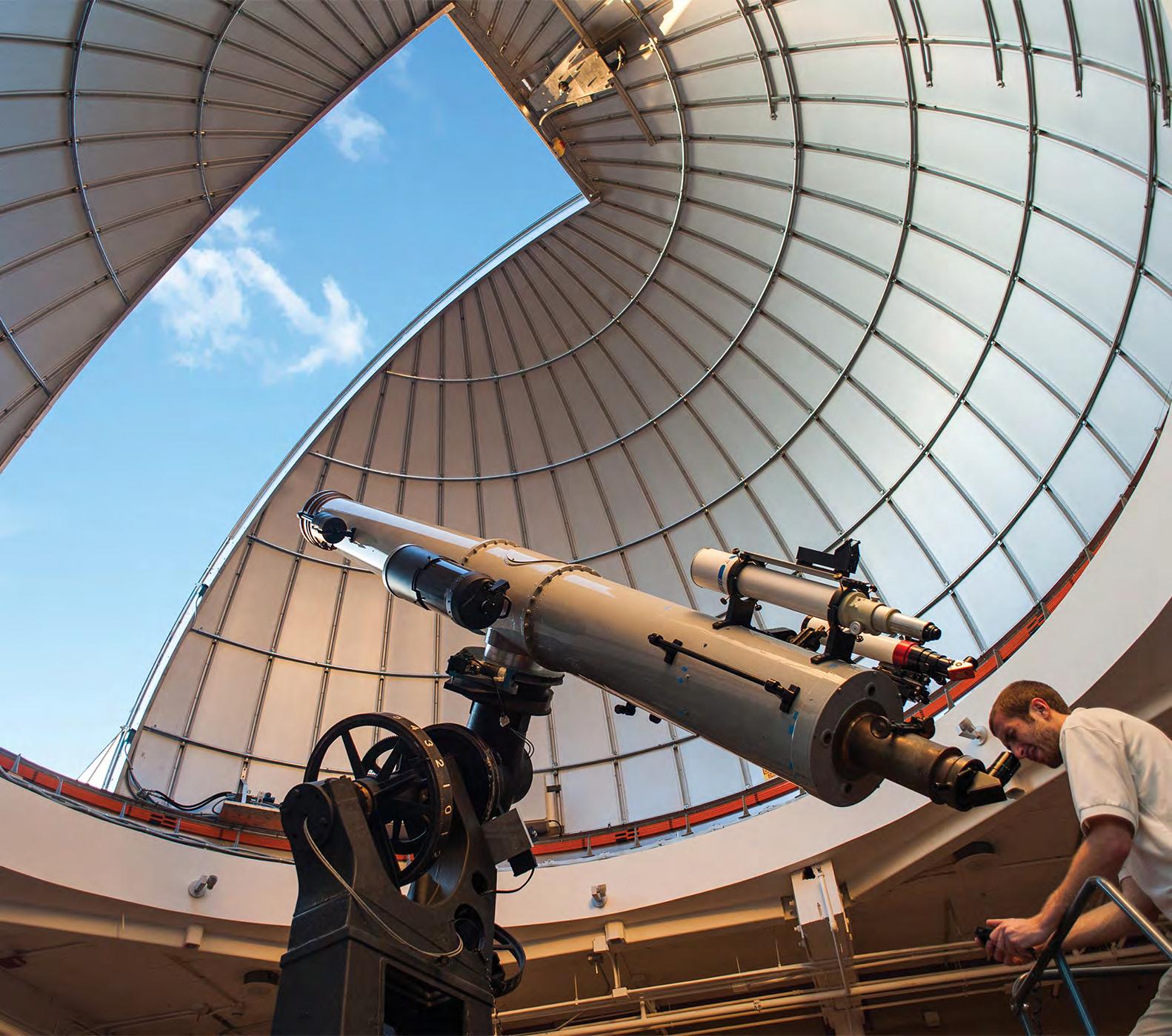
27 SCMUSEUM.ORG | 301 GERVAIS STREET BE INSPIRED Explore Science, Art, History & More Visit Today
USC LEADS RIVALRY GAME WINS AGAINST CLEMSON


Xavier Martin
In 2022, South Carolina took home its first ‘Palmetto Bowl’ trophy since 2013 after the 31-30 upset against Clemson at Memorial Stadium on Nov. 26, 2022. However, the Gamecock-Tiger rivalry goes beyond football. In the past year, South Carolina has defeated Clemson across six sports in the Palmetto Series, including both men’s and women’s basketball, football, baseball and men’s tennis. The Tigers, however, were able to beat the Gamecocks in men’s soccer, women’s tennis, volleyball and most recently, softball, while tying 2-2 in women’s soccer. The rivalry continued with a volleyball match between the two teams on April 2, 2023, and a second round of softball on April 11, 2023, both in Columbia.

South Carolina players cheer after winning the Palmetto Cup, beating Clemson 8-5 in the final game of the season on March 3, 2023, at Flight Adventure Park in Irmo, South Carolina. The Gamecocks ended up winning 3-0 in the Cup series overall. The team also beat the Tigers 5-4 on Nov. 11, 2022, in Irmo, South Carolina, and 7-1 in Greenville, South Carolina, on Jan. 28, 2023.

28
Sophomore winger Brody Smojice gets ready to face off against Clemson during Gamecock club hockey’s first rivalry game of the season at Flight Adventure Park in Irmo, South Carolina, on Nov. 11, 2022. The Gamecocks beat the Tigers 5-4.
Senior infielder Braylen Wimmer slides into home plate, scoring a run for South Carolina in the fifth inning against Clemson at Founders Park on March 5, 2023. The Gamecocks beat the Tigers 7-1, taking the series 2-1.
Photo: Rachael Barkoff
Redshirt junior quarterback Spencer Rattler (left) celebrates with (from left to right) redshirt junior tight end Traevon Kenion, junior running back Juju McDowell and junior tight end Jaheim Bell after he completes a pass to McDowell during the matchup between South Carolina and Clemson at Memorial Stadium in Clemson, South Carolina, on Nov. 26, 2022. The Gamecocks upset the Tigers 31-30, marking the first time South Carolina has beaten Clemson since 2013.
photo: Jerry Bowen




29
Junior Connor Thomson serves the ball over to his Clemson opponent during a doubles tournament at the Carolina Indoor Tennis Facility on Feb. 3, 2022. The Gamecocks beat the Tigers 7-0, marking the third consecutive year South Carolina has claimed the matchup.
photo: Zoe Kennedy
Freshman forward GG Jackson shouts in excitement after making a putback dunk in the match against Clemson at Colonial Life Arena on Nov. 11, 2023. The Gamecocks beat the Clemson Tigers 60-58.
photo: Brodie Perry
Flames quickly catch and spread throughout the 32.5-foot-tall tiger statue during the Tiger Burning ceremony at the Bluff Road intramural fields on Nov. 21, 2022. The annual event with the University of South Carolina engineering department marks the beginning of rivalry week in preparation for the South Carolina and Clemson football game.
photo: Sydney Connor
Junior first baseman Gavin Casas points to the batter’s eye after hitting a home run to center field in the fourth inning against Clemson at Founders Park on March 5, 2023. The Gamecocks beat the Tigers 7-1, taking the series 2-1.

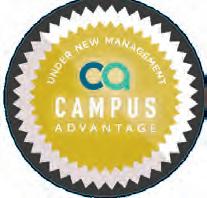
30 Welcome to The Rowan — Columbia’s premier off-campus housing community now under new management! Located near the University of South Carolina, our one-, two-, three-, and four1051 SOUT HE R N DRIV E • COLUMBIA , SC 29201 (803 ) 255-0170 ROWANAPARTMENTS.COM RATES AS LOW AS $645!
‘SAMI’S LAW’ leaves lasting legacy 4 years after tragedy
jack wolfe
Samantha Josephson, a fourth-year political science student and former sister of USC’s Alpha Gamma Delta chapter, was on track to attend Drexel University’s law school in Philadelphia in 2019.
But while waiting for an Uber during a Friday night out with her friends, Josephson mistakenly entered the wrong vehicle and was kidnapped. Her abduction and murder shocked USC and the nation at large.
Four years later, Josephson’s death continues to inspire action across campus and at the federal level.
On Jan. 5, an act coined “Sami’s Law,” was signed by President Joe Biden. The bill works to address safety requirements for passengers and drivers of ride-sharing companies.
The act requires the Government Accountability Office to submit a report every other year to Congress that documents physical and sexual assaults, requires background checks for drivers and oversees rider and driver safety precautions implemented by ride-sharing companies.
Following Josephson’s disappearance and death, Associate Vice President of Student Life Anna Edwards said students across campus experienced “unbelievable pain.”
“She was so well connected with lots of students and student organizations, and it’s just hard to make sense of something so horrific that happened in our community,” Edwards said.
Former Student Body Vice President and a sister of USC’s Alpha Gamma Delta chapter Maia Porzio said many members “looked up” to Josephson and her ambitions.
“She was about to graduate,” Porzio said. “(She) was a role model for a lot of people in the chapter, who then passed away in a serious situation like this.”
Josephson’s parents founded the #WhatsMyName Foundation to bring awareness to Josephson’s story and serve as a reminder for ride-share safety.
According to its website, the foundation encourages passengers to ask “What’s my
name?” so users can make sure they are entering the correct car and ensure that “no other family would have to suffer this kind of loss.”
#What’sMyName developed the acronym S.A.M.I. (Stop, Ask, Match, Inform) as a way for people to remember the steps of confirming their ride-share vehicle before they enter it.

Collaborating with Josephson’s parents, Porzio and then-Student Body President Issy Rushton introduced Safety Week. The week educated students on safety resources and had a day dedicated to Josephson. Her father, Seymour Josephson, talked to students via Zoom about how they can stay safe when entering an Uber or Lyft.
Outside of Safety Week, the university also teaches Josephson’s story through the University 101 curriculum as a way to maintain her memory. In her class, U101 instructor and undergraduate academic advisor Brandi Byers tells Josephson’s story and discusses how to safely use ridesharing apps.
“A lot of the students, particularly instate students, talked a lot about how their parents either wouldn’t let them do any ride-sharing, or they would make them go through the steps,” Byers said.
Byers said that while Sami’s Law doesn’t encompass every aspect of ride-share safety, it is a start. She also hopes that Sami’s Law will continue to help legitimize Uber and Lyft drivers by keeping fake drivers off the street.
While Edwards said Sami’s Law marks progress in providing safety for passengers using ride-sharing apps, she also said staying aware and alert when entering an unknown vehicle is something that everyone should do, on or off campus.
“The responsibility is for folks — whether it’s an advisor or a staff person — to really incorporate the tenants of the message and what her story means,” Edwards said. “When someone asks you your name and there’s a light up sign, all of those things are because of what happened to her.”
31
infographic: sydney Lako
NEW BILLS IN SOUTH CAROLINA ARE FEMICIDE, NOT ‘ABORTION BANS’
Femicide is defined as the deliberate killing of a woman or girl, in particular by a man, and on account of her gender.

There doesn’t seem to be a better fitting definition to explain why South Carolina legislators want to introduce a bill that subjects women who receive an abortion to the death penalty. In fact, it seems like there’s no other reason why a predominantly male government is so determined to punish, imprison, shame and even execute women for undergoing a medical procedure other than pure misogyny.
Even though the South Carolina Supreme Court declared the S.C. Senate’s attempt at an abortion ban unconstitutional, that hasn’t stopped the state legislature from coming up with new, similar bills. In fact, the state House of Representatives just passed another near-total abortion ban in February.
The “Fetal Heartbeat Act,” which banned abortions after only six weeks with minimal exceptions for the mother’s life and victims of rape or incest, was signed into law by Gov. Henry McMaster in 2021, but it was quickly blocked by the U.S. Court of Appeals for the Fourth Circuit.
The ban was lifted briefly after the overturning of Roe V. Wade in 2022
Kat Smith
but was then found unconstitutional in January 2023.
Todd Rutherford, the Democratic minority leader of the South Carolina House of Representatives, said that the South Carolina Supreme Court found the Fetal Heartbeat Act unconstitutional because women have a right to privacy.
“They’re trying to say that a fetus is a person at conception,” Rutherford said. “They base it on no science, just an overriding desire to tell women how to deal with their own bodies.”
But that isn’t the only angle for this bill. If a fetus is legally declared a person at conception, it is possible that having an abortion could be considered murder, which is punishable by the death penalty in South Carolina. It is ironic that conservative lawmakers and their supporters hold the mantra of being “pro-life” while trying to subject women to death for undergoing a medical procedure.
“It is sick, it is misogynistic, and unless people get out and vote, they can expect more of the same,” Rutherford said.
H. 3549, the South Carolina Prenatal Protection Act aims to apply the laws for victims of homicide or assault to an unborn fetus. This means that a woman who receives an abortion could receive up to life in prison and possibly even the death penalty.
These bills not only go against the U.S. Constitution but the South Carolina Constitution as well. Article I, Section 10 of the state’s constitution grants “the right of the people to be secure in their persons,” and that “unreasonable invasions of privacy shall not be violated.”
It seems like abortion bans in any state violate the promise of protection of individual liberty, health and safety. Where will the government draw the line on just how much they can control? Do “separation of church and state” or “freedom of religion” no longer have
merit in the Constitution? The U.S. was founded under the very problem of a lack of religious freedoms and acontrolling government.
And lawmakers likely won’t stop at criminalizing abortions. Bills like H. 3549 are also dangerous for women because they impede on their basic right to privacy with their healthcare providers. Critics of the bill believe that these types of laws will not only prosecute women who choose to have an abortion, but people who have miscarriages as well.
If South Carolina lawmakers truly cared about saving lives, then they would be more concerned about foster care youth, gun safety and the death penalty. But the truth is that the “pro-life” viewpoint has never been about life at all, just disdain at the thought that women are capable of making decisions about what is best for their own body. Women have more of a purpose in life than being mothers and housewives.
This bill could incite the killing of countless women if they refuse to give up control of their bodies and independence. If lawmakers think that women in South Carolina will sit back and take this abuse, then they are in for a rude awakening.

32
column:
Photos: Calista Pushman
A protester covered in blood-colored paint holds up a pro-abortion sign labeled “I’ll Just Do It Myself” during the Dobbs v. Jackson protest at the South Carolina state capitol on June 25, 2022. The protest came as a response to the overturning of the landmark Roe v. Wade case earlier that June.
Protestors hold up pro-choice signs during the Dobbs v. Jackson protest at the South Carolina Statehouse on June 25, 2022. The protest came as a response to the overturning of the landmark Roe v. Wade case earlier that June.

33
Infographic: Clay Laucella

34
Gamecock men’s basketball experiences series of highs, lows in first season with Paris
Jacob phillips
The South Carolina men’s basketball team’s season-long journey consisted of many high and low points in what could be described as an inconsistent year in a program-defining season.
The Gamecocks had a few bright moments but struggled, finishing 11-21 overall and 4-14 in the SEC during the first season under head coach Lamont Paris. Despite the record, Paris said the team displayed a lot of growth.

“It’s hard to describe how much growth that there was this year,” Paris said. “I’m happy about that and thankful for that, but there is a lot of foundation that’s been laid.”
The Gamecocks’ season ended in the first round of the SEC tournament, but graduate forward Hayden Brown said the players on this team can hold their heads high knowing they were the start of a new culture.
“I feel like we have built something. It was started, a foundation was laid,” Brown said. “I’m just excited to see where the program heads, and I was just incredibly grateful and thankful and happy and excited to be a part of it in the first year.”
South Carolina finished near the bottom of the SEC in almost every metric, having the second most points allowed per game while also scoring the least points per game and finishing with the worst overall win percentage.
The Paris era started hot when the first-year coach landed a commitment from the program’s highest-rated player, freshman forward Gregory “GG” Jackson II.

Jackson was previously the No. 1 ranked recruit in the class of 2023 and committed to North Carolina. He decommitted from UNC on July 14 and nine days later announced his decision to forgo his senior year and join the Gamecocks.
Jackson’s season, like the team’s, was inconsistent — he showed many bright spots but struggled to adjust to the physicality of SEC play.
Overall, Jackson averaged 15.4 points and 5.9 rebounds per game this season, but his scoring outputs were sporadic at times. He had 11 games where he scored at least 20 points but also seven games where he scored less than 10.
This season could ultimately be Jackson’s only season in garnet and black, as he declared for the 2023 NBA Draft in March.
The team captured a few important wins throughout the season. South Carolina beat its rival Clemson 60-58 and earned a 71-68 upset win over Kentucky, its first road victory against the Wildcats since 2009.
Sophomore guard Meechie Johnson scored a season-high 26 points in that game, adding six rebounds and six assists.
“Coming out with a win was all that really mattered to me during this whole game,
coming off a loss like we did,” Johnson said. “They were 9-0 here, so we just wanted to make something happen.”
The Gamecocks closed outof-conference play on a high note, going 4-2. But the team’s weaknesses were exposed early on in conference play. The team found itself near the bottom of the SEC standings after going on an eight-game losing streak against conference opponents.
The Gamecocks captured three wins in its last seven regular season games, but it was not enough to recover in the standings, finishing as the thirdworst team in the SEC.
The three victories came over fellow conference basement dwellers Georgia, Ole Miss and LSU, who all finished in the bottom four of the conference. But even in its losses, the team still showed improvements.
South Carolina even managed to go wire-to-wire with the then-ranked No. 2 team in the nation Alabama. The Gamecocks fought but failed to survive freshman forward Brandon Miller’s career-high 41 points, losing 78-76 in overtime.
The season officially ended with a 67-61 loss to Ole Miss in the first round of the SEC tournament.
“Down the stretch, we had a chance, and then just fell short, didn’t make some plays down towards the very end,” Paris said. “But I’m thankful for our guys and what they’ve been all season, who they’ve been ... I was really happy with their effort.”
Next season, the team is expected to look very different.
Johnson also declared for the draft, but like Jackson, the door is open for a return. Brown
exhausted his athletic eligibility after six seasons of college basketball.
Senior guard Chico Carter Jr., junior forward Ja’Von Benson, junior center Tre-Vaughn Minott, freshman forward Daniel Hankins-Sanford and senior guard Ford Cooper have all entered the transfer portal.
The team has started searching for new talent to improve the roster. Paris said this year was a good start, but every team is looking to add more talent.
The team’s 2023 incoming freshman class features two three-star Columbia natives, Arden Conyers from Westwood High School and Collin MurrayBoyles from Wasatch Academy. The team has also picked up two transfers — senior forward Stephen Clark from the Citadel and junior guard Ta’Lon Cooper from Minnesota.
“I think plugging and improving your overall talent level, whether that’s physically, whether that’s from a skill standpoint … getting that all put together,” Paris said. “Almost all of our time will be involved in that.”
35
illustrations: sydney Lako
photos: rachael barkoff & taylor kitchens
Student performers show range in USC theatre’s 2022-2023 season
Fiona Schreier
Over the past year, the USC Theatre Department has produced five shows. From breezy comedies to contemporary dramas, these shows feature a range of styles and subjects, highlighting the versatility of the department and its actors.
“A Midsummer Night’s Dream”
The season began last October with “A Midsummer Night’s Dream,” a Shakespearean comedy. Directed by Devin Haqq, the play follows several storylines, including four young lovers who run away to avoid arranged marriage, a fighting fairy king and queen and a group of craftsmen who are trying to rehearse a play. The stories each include magical consequences, such as complicated love spells and dangerous transfigurations.
Rowland Marshall, a second-year theatre student, played Oberon, the king of the fairies, and said the show was altogether an extensive learning experience.
This production featured two new elements: It was performed outdoors on a stage specifically built for the show by the university and Folger Theatre, and it swapped the parts of the fairy king and queen. Typically Oberon casts a spell on Titania, but, in this production, it is Oberon who falls in love with Bottom, a man turned into a donkey.
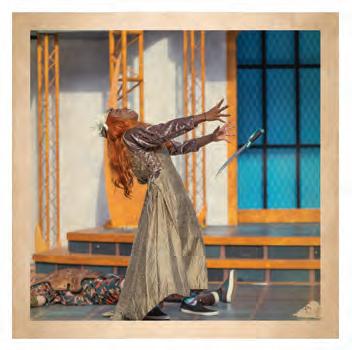
“It felt like a top-secret mission,” Marshall said. “It was very experimental. It didn’t feel like it was all planned out at any moment, and I felt like we were all kind of solving it together.”
“Small Mouth Sounds”
“Small Mouth Sounds,” written by Bess Wohl, ran last November. In sharp contrast to “A Midsummer Night’s Dream,” which uses complex language, “Small Mouth Sounds” follows six characters who attend a silent retreat, meaning the play takes place almost entirely without words.


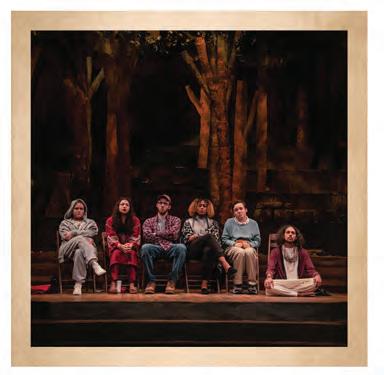

Carly Siegel, a fourth-year theatre student, played Joan, a sex therapist who attends the retreat with her partner, Judy. To play her character without words, Siegel relied on her physicality and connections with the actors on stage as well as the retreat teacher’s voice, which is the show’s only source of dialogue.
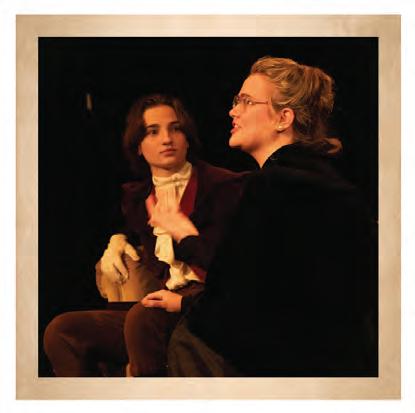
“The big thing was that it was active listening. If we zoned off onstage while the teacher is speaking to us, then we’re going to miss an opportunity, or we’re not going to react, and that’s going to slow down the play,” Siegel said.
The 10 Minute Play Festival
The 10 Minute Play Festival, produced in February, took a very different form from the department’s other productions. Rather than one show, this festival put five 10-minute plays together, each directed by a different member of the theatre faculty. These plays ranged from comedies to dramas, giving theatre students the chance to shine across genres. Marshall was cast in “The Bear,” by

36
Anton Chekov and directed by Dustin Whitehead, where he played Smirnov, a Russian debt collector who comes to collect from a woman who’s husband recently died. Although the premise initially sounded grim to Marshall, he said it was rewarding to find the comedy in his character.
“I had this idea of this wounded animal, kind of really tormented guy, but I had to find the comedy (and) the lightheartedness in it,” Marshall said. “And it’s much more rewarding, because I think all that anger and stuff is really easy to do. But the soft stuff, that’s what’s difficult.”
“The Light”
“The Light,” produced in March, featured just two actors. The play follows a recently-engaged Black couple who confront their different ideas on issues of sexism and racism.



Shakori Jennings-Shuler, a graduate student studying for her masters of arts in teaching in theatre, played Genesis, a school principal who has to navigate the challenges of being a Black woman in today’s world.
The play is primarily a debate between the couple over the intersection of racism and rape culture. The couple debates what it means to support artists in light of accusations, whose accusations are believed and how it affects the community. The two characters address familiar concerns, ones that Jennings-Shuler said struck a nerve with her and her friends.

“The fact that women will be seen and heard with my literal lines, I just think there’s so much power behind that,” JenningsShuler said. “And I think that our department choosing this show just means a lot, because I think more people need to see it than they think they need to see it.”
“Little Shop of Horrors”

To close out the 2022-2023 season, the theatre department produced its first musical, “Little Shop of Horrors.” The show is a horror-comedy where Seymour, a poor employee at a plant shop, meets an alien plant that boosts the store’s sales but feeds on human blood.
Siegel plays Chiffon, one of the street urchins that serve as a doowop chorus.
“There’s space stuff, there’s bejeweled dresses, there’s bright colors, there’s a man-eating plant, there’s a sadist dentist,” Siegel said. “It’s very entertaining.”
Siegel said the shift from a mostly silent play to a musical wasn’t very jarring. Aside from a longer rehearsal process, she said many of the same techniques for a silent performance are useful for a musical.
“(In) ‘Little Shop,’ you use your physicality a lot in that, too,” Siegel said. “Because of our lack of lines, we’re still reacting and we’re watching everything, so we have to be, once again, present on stage.”
Looking back at her USC theatre career, Siegel said she loved the variety in the shows she’s been in.
“I’ve had just so many favorite shows. Each show is so incredibly different and unique,” Siegel said. “I am incredibly lucky to have gotten all the roles and have done everything that I have done at USC.”
37
Photos: xavier martin & courtesy of jason ayer
illustrations: gillian Thomas
column:
Critical race theory plays important role in education; legislation should be examined carefully
Critical race theory and the impact of ideology in education has been a growing topic in South Carolina, and as such, it should be thoroughly examined, debated and rationalized since its significance is heavily impactful to students and the South Carolina education system.
Critical race theory is defined by the Oxford English Dictionary as a theoretical framework for examining the influence of racial bias on social and cultural institutions and practices. H. 3464, a new bill that is currently residing in the S.C. House of Representatives, aims to prohibit the instruction of critical race theory.
This bill not only affects public schools and school districts, but also public institutions of higher learning. From classroom rhetoric, literature, activities and discussions, a ban on critical race theory would have a large array of effects on what goes on in schools.
“Schools would be required to stay with the agenda that the Department of Education has put out and keep these teachers from wavering too much off of base,” S.C. Rep. Mike Burns (R-Greenville) said.
Burns’ constituents in South Carolina’s 17th district have approached him with concerns about the potential ideological impacts for high school students’ education that they want corrected by H. 3464.
“I had a lady show up to my house, on my steps,” Burns said. “Her graduating senior son was taking a college transfer course for class credit — for future college credit, also. And he was instructed to write a paper apologizing for being white, and he wouldn’t do it. And they failed him. He failed the course.”
Bill H. 3464, sponsored by Burns, would not allow public education to introduce instruction or units of study compelling students to adhere to any tenets of critical race theory. This would mean that students could not seek instruction or engage in discourse involving the presence of critical race theory in the classroom.
Vivek Crowe
The bill includes sex, race, ethnicity, religion, color and national origin under the language of critical race theory.
It is clear that there is opposition to ideological teachings concerning race, gender and sexuality under the umbrella of critical race theory. On the other hand, students such as first-year psychology student Piper Phipps, who have grown up within the South Carolina education system, feel there is a need for the understanding of race, gender and sexuality in today’s world.
The hasty effort to enact legislation against critical race theory could have an effect on everything from the literature students read to classroom discussions and activities. According to a 2022 study from PEN America, at least 40% of book bans (1,109 books) are due to proposed or enacted legislation opposed to critical race theory and ideological teachings in schools. PEN America’s index of school book bans has tracked 2,532 decisions to ban books from July 1, 2021, to June 30, 2022.
There is a considerable consequence of banning ideological discourse in public education, as these instances are prevalent in society today. A study conducted by the National Library of Medicine concluded that sex, gender, race and ethnicity play important roles because of their social implications.

“Aspects of gender and sexuality are such a big part of real life,” Phipps said. “The best way for children to be more accepting and knowledgeable about these things is through being educated.”
“I took a health and wellness class in high school, and it did talk about gender and sexuality,” Phipps said. “I think it’s a positive impact to have the kids learn about it and expose those ideologies to those kids, because it’s the real world. You can’t really avoid the real world. You have to learn about it — be exposed to it.”
There are consequential negatives and drawbacks to banning the discussion of race, gender and sexuality in the classroom, and a consensus about critical race theory is difficult to reach, as its impact is seen across the nation. This is why nothing should be banned immediately or without careful thought and reason. Heedlessly banning something that provokes ideas and discussions of the real world, such as race and gender, could be harmful to students.
The study also includes the contributions and importance of sex, gender, race and ethnicity in genetics and the environment. Discussing the social constructs of gender and ethnicity fall under the umbrella of critical race theory, and the study is evidence that these ideologies are valuable to public education systems.
A ban on the language and content of critical race theory would also limit the extent of what professors and teachers could discuss with students in classrooms, even though the issues being discussed are abundant these days. If students aren’t receiving this level of education, they could develop a gap in knowledge by the time they reach institutions of higher learning, where they deserve to have a say in what they learn and discuss in a classroom.
Passing state legislation with regard to critical race theory in the South Carolina education system should require thoughtful consideration, as it has a significant impact on students and higher education in the state.
38
Illustration: Julia Lako


Fully furnished Full-size washer & dryer Cable TV & WiFi included Apartment Features CALL803-779-3280 forcurrentrates!
Softball fifth-year players return to continue education, reunite with teammates
Over their last four years with the Gamecocks, infielder and catcher Jordan Fabian, outfielder Haley Simpson and pitcher Rachel Vaughan have dealt with many highs and lows, from a suspended season due to COVID-19 to multiple season-ending injuries.

When the 2020 season was suspended during the pandemic, the Gamecocks had a 17-6 record after 23 games and were coming off of two wins over Coastal Carolina and Winthrop after a competitive weekend in Athens against the University of Georgia.
Three years later, Simpson, Fabian and Vaughan have all chosen to utilize the extra year of eligibility they received from 2020 and return for a fifth year.
“I think we all felt that we had gotten gypped on our COVID year,” Simpson said. “We were having a good year, we were ready to face LSU right before they called the season. We came off a good weekend at Georgia, and we all felt like we got cheated out of it, and so I think we all decided then and there if they were going to give us the opportunity, we were going to come back.”
Fabian said the chance to get a master’s degree was one of her incentives to return.
“One, I wasn’t ready to give up softball, wasn’t ready to hang up the cleats, and then two, I had the opportunity to continue my education,” Fabian said. “I started my grad program this fall, so I’m in my second term of that, so it was just too good to give up on right now.”
Like Fabian, Vaughan said her education was one of the main reasons for her return.
“I’m able to get my master’s degree and continue my education that way,” Vaughan said. “So it’s just a great opportunity to be able to come back and finish my fifth year out with all these great people.”
Fabian, who has been playing with Simpson and Vaughan since their freshman season in 2019, said the relationships she has formed with teammates also encouraged her to come back for another year.
“It’s been a lot of fun the last few years, this year too. Like I said, I wasn’t ready to hang it up and tell my girls goodbye,” Fabian said. “I’ve definitely made some lifelong friends here, and it’ll definitely be sad when it’s done.”
Fabian, Vaughan and Simpson have helped provide an on-the-field spark with their veteran presence while serving as leaders off of the field, as well, head coach Beverly Smith said.
“They add a lot of experience, a lot of maturity, and I think we’ve got transfers who also bring that as well,” Smith said. “So they’ve come in and added experience and, I would say, wisdom and perspective for us, too.”
Even though all three fifth-years are now regulars on Smith’s lineup card, their collegiate journeys are far from similar.
Fabian struggled in her first season as a Gamecock, carrying just a .187 batting average in 50 games. However, she rebounded after the 2020 shortened season, hitting .258 over 49 games played in 2021. She further improved in her 2022 season, hitting .303 and walking a programhigh 42 times.
Vaughan pitched just under 30 innings in each of her 2021 and 2022 seasons. She had a bounceback year in 2021 after throwing for a 4.35 ERA in 27.1 innings pitched through 11 games with the Gamecocks. In 2022, Vaughan pitched to a 2.96 ERA in 28.1 innings pitched over 19 games.

While Fabian and Vaughan were nearly everyday contributors, Simpson had to wait awhile before getting her chance. Simpson last saw consistent play during the shortened 2020 season. Through 21 games in that season, Simpson hit for a .353 batting average with seven stolen bases. In her only full season as a Gamecock in 2019, she had a .264 batting average with a perfect fielding percentage over 47 games played.

Simpson would miss the entirety of both the 2021 and 2022 seasons with injuries, but she announced her return this season with a bang. In her first at-bat in 1,086 days, Simpson hit a home run that extended South Carolina’s lead over Western Kentucky to nine runs on Feb. 19.
“If we can keep (Simpson) in the lineup, that’s gonna be key,” Smith said.
With the return of Fabian’s and Simpson’s bats plus Vaughan’s pitching, Smith hopes to reach her goal of hosting a regional in this year’s NCAA tournament.
40
will kelly
illustrations: clay laucella photos: rachael barkoff, sydney dunlap & sarah murphy
Students need to budget to get through inflation spike
With inflation surpassing 17.67% over the last four years, college students need to budget in order to counteract the damage high inflation has done to their bank account.
Grocery items have doubled in price, gas prices are up 22% ($2.59 per gallon in 2018 compared to $3.16 in 2023) and the cost for a date night has increased by 47% ($84.92 in 2018 compared to $159 in 2023), due to increases in production costs and global conflict. The best way to combat these expenses is to establish a budget.
USC finance professor John Hackney said that the best way for students to battle inflation is using run-of-the-mill budgeting and becoming literate in basic personal finance techniques.
Understanding your monthly income is a great first step in deciding how you need to begin budgeting. While this may sound tedious, your bank app or a personal finance app like Mint can help you recognize where your money is going.
While inflation is universal, there are goods and services you can avoid to save yourself from the spike.
Restaurant prices, airfare and utilities are some services that can be cut back or used only when necessary. If you map out where most of your money is going and figure out if the big expenses are a need or a want, then you should find substitutes or just avoid “want” costs when able.
Susanna Johnson
The biggest mistake students make is not becoming fully financially literate, Hackney said. Things like not having a credit card — and therefore not having a credit score — not knowing when and how to start saving and not understanding interest payments are all things Hackney said can hurt you financially later on.
“Understanding the basics of how a loan works and payments. I think that those are the biggest issues,” Hackney said.
Contrary to what Dave Ramsey, a personal finance radio coach says, credit cards are a great way to start building your credit, helping you in the future with lower loan rates, as well as free perks that come along with paying your credit card balance off each month.
“A lot of students, you don’t have a credit history, so you don’t have a credit score, which hurts you when you go out into the real world,” Hackney said.
This doesn’t mean get a credit card, go on a shopping spree and hope that you can pay the bill off at the end of the month. Use your credit card alongside your budget, with constant
reassurance knowing that you will be able to pay it off soon.
Seventy percent of college graduates leave school with student loan debt, and understanding payments and the ways loans work is much more important than worrying about making investment mistakes. With President Joe Biden’s student loan forgiveness plan up for debate in the Supreme Court, many graduates need to know what to do if it doesn’t remain. Know how compounding interest works and ways you can use the interest for your own good. If saving is something you can afford to do, get on it. Interest rates are higher than normal, meaning you can get a much more significant rate of return on your investment in a savings account.

Hackney said you should start saving as early and as much as possible and let compounding interest do the rest.
Most importantly, you should do your research to find online savings accounts that will serve the largest yield in return. The average savings account rate for a brick-and-mortar bank is 0.23%, but
if you shop around and find an online savings account, you can earn close to 5% on your savings. Take the time to find a good one, and the reward will be worth it. When searching for an online bank, make sure it is insured by the FDIC, and you will be covered just like you would for your normal bank.
If you were to deposit $5,000 into your normal bank savings account, you would end up with $5,011.50 after a year, but putting that money into a lowrisk, high-yield savings account could earn you $5,250 after one year. After 10 years, you are making more than $3,000 more, just by simply putting your money into a different savings account.
When figuring out how much you should be saving, go back to your budget. You shouldn’t just be putting whatever you have left over at the end of the month into savings. Savings should be an allotted part of your budget, just like your other spending needs.
If you can directly deposit your work check into a savings account, that is your best bet, so you won’t be tempted to spend that money on other moneyeating areas.
Start budgeting, saving and understanding personal finance basics, and you will be able to prosper financially.
“All of the changes are small,” Hackney said. “But it can have a big impact.”

41
column:
Illustration: Allie Dunlap
Club hockey helps bring sport to South with rising social media following
 Ky Villegas
Ky Villegas
When the South Carolina club hockey team was created in 2001, it started off as a group of friends who wanted to continue playing hockey. Now, through its social media, success on the ice and merchandise sales, the team has grown its presence at South Carolina.
However, this growth stalled abruptly during the COVID-19 pandemic.
Since there were not any games being played during that time, Cock Hockey had to rely on social media to promote itself in order to stay relevant, according to Liam Gormley, a senior goalie on the team and the head of creative media.
“When we learned we didn’t have a season, I was looking for ways to stay involved, and my roommate at the time, Ben Smith, was in charge of all our creative media and our social media stuff, so I started helping him make TikToks and other stuff,” Gormley said. “His last words to me were, ‘You’ll figure it out.’”
Over the past two and a half years, Cock Hockey has accumulated 38,500 followers across three different social media platforms as of April 1.
Between Instagram, TikTok and Twitter, Cock Hockey’s most popular account is
its TikTok, which has more than 17,000 followers. Its Instagram page has more than 14,000 followers, 5,500 of which were added during the 2022-2023 season.
Its oldest page, Twitter, has amassed about 7,300 followers since its creation in March 2012. The page gained 4,800 followers during the past two and a half years, with 2,100 of those followers coming over the course of the 2022-2023 season.
All of this popularity online has translated to ticket sales.
During the 2019-2020 season, the team sold out four games — two of which were against rival Clemson — and in the 2021-2022 season, the team completely sold out five of its games and ran out of student tickets for two others.
This season, Cock Hockey sold out the final home game against Clemson in under six minutes. This was the third sold out game of the season, alongside the season opener against the College of Charleston and a Friday night game against the University of Tennessee.
“To be able to go out — and just hearing all the fans instead of going into an empty arena — it definitely makes you want to play a hundred times more,” sophomore defender
Ronan Mulkerrin said. “Especially being from up North, you play a high school hockey game anywhere, (it’s) sold out, and coming down here, I really wasn’t sure how it’d be.”
Another direct impact of the popularity of Cock Hockey has been in recruitment.This past season, junior defenseman Zach List joined the team as a transfer from an NCAA Division III school, and freshman center Jake Puskar committed to the team after learning about it on social media.
As a club organization, Cock Hockey receives some funding from the university. According to senior winger and team captain Mike Bolger, however, the amount is less than 1% of its overall funding.
A majority of its funding comes from merchandise and jersey sales. The merchandise sales — items such as pins, sweatshirts and hoodies — are dependent on home game attendance. Jerseys, which can be bought online during a limited time frame, are the only things that are sold outside game days.
Over a two-year period, Cock Hockey had over 3,000 sales, which allowed it to support travel for away games, conference championships and national championship tournaments, according to the team.
During the 2022-2023 season, the Cock Hockey merchandise team came out with a black jersey with “Cocks” on the front. The jersey won The Hockey House podcast’s Jersey of the Year award and made an appearance on a Barstool Sports hockey podcast through its Instagram account called Spittin’ Chiclets.
Co-captain and senior center Mike Bolger said he remembers when the team passed out pamphlets on Greene Street to spread the word about Cock Hockey — a stark contrast to its multiple sold out games in the 2022-2023 season.
“It’s kind of a tribute to our social media content, and we’re more competitive on the ice than we were then,” Bolger said. “The biggest changes (have) been fan interactions, and every year we just get better players.”
42
Photo: xavier martin
Freshman center Jake Puskar celebrates with fans after scoring a goal for South Carolina during the rivalry match against Clemson on March 3, 2023. The Gamecocks beat the Tigers 8-5.
New leadership of National Pan-Hellenic Council works to ease operations, push representation of organization on campus
Carolyn Barbieri
In the 2022-2023 academic year, the National Pan-Hellenic Council experienced growth, established a plan for a lasting legacy and reworked its bylaws as the organization aims to grow its impact at USC.
The NPHC, a national collaborative organization composed of historically African American fraternities and sororities, spent the majority of the summer and fall planning the biannual “Stroll Off” in conjunction with the Homecoming Commission.

Open to all, the event drew alumni and spectators from local HBCUs, who came to support their respective chapters and watch members of each fraternity and sorority perform choreographed dances characterized by stepping, strolling and chanting.
Sarah Helen VanDevender, a graduate higher education and student affairs assistant, works in the programming department at the Office of Fraternity and Sorority Life and plays a role in advising for the NPHC. VanDevender said events like this one have welcomed growth since she arrived on campus in 2021.
“We had all eight chapters participate, which is really incredible because when I first came here, I think only four were participating, so we’ve got an increased involvement, which is incredible,” VanDevender said.
Fourth-year social work student and newly-elected programming chair of the NPHC Kennedy Lann said the mission of the NPHC’s involvement on campus is to provide the opportunity for students to present themselves
as they are. She said the council is especially important at a predominantly white institution.
“For NPHC, it’s important to be established at a (predominately white institution) mainly because we represent diversity,” Lann said. “The mission for us to be created was to create equality for all African Americans, to be seen and to be represented.”
In addition to the increase in participation, VanDevender said the NPHC has also begun planning a new monument that would represent all eight chapters on campus. Through a lengthy process, the council has been connecting with administrators and creating contracts to generate the memorial.
“It’s taking a lot of discussion to have eight chapters come together and decide ‘What do we want this to look like?’ because it’s representing all eight chapters, but they all have different opinions, of course, on what representation looks like to them,” VanDevender said.
Lann said council members are currently working to find ways to fund the monument as well as deciding where it will stand on campus.
Along with planning events and the monument, the NPHC has also taken to revamping its old bylaws and statutes that have resulted in difficulty planning some events throughout the past academic year.
Charter week is an important time for the NPHC chapters to host events to present their individual fellowships and their commitments to possible new members. Lann said that, for fraternities and sororities hosting their own charter weeks, they can
run into difficulty finding available time slots.
Lann said the NPHC fraternities and sororities were having difficulty finding the willingness to share event days — something that has to be done to meet the deadlines of the university’s Office of Fraternity and Sorority Life. She said that the council’s vice president, Davon Beaton, is working with their parliamentarian to “create equality” in the scheduling of events between member organizations.
NPHC President Brandon Vereen, along with the executive team, have spent many of their recent biweekly meetings revising and updating their governing rules and regulations in an attempt to create better organization among the eight fraternities and sororities.
“The bylaws haven’t been updated since probably COVID or 2021, so we’re just trying to make sure that they’re clear and concise,” Vereen, a third-year sport and entertainment management student, said. “Getting everyone’s approval to make sure everything works out has been mainly the only
thing — it’s been, not challenging, but something that was more that we can work towards.”
VanDevender said the ongoing project of creating an organizational calendar will help to clear up scheduling conflicts among the fraternities and sororities in the future.
The calendar would assign certain dates to certain chapters, giving them the chance to hold new member presentations, fundraisers, educational sessions and other organizational events without the challenge of having to work around other chapters’ dates.
“Our conversations have been based a lot around, ‘Is that helping the visibility of NPHC on campus?’ and ‘How can we increase NPHC events to get their presence more known on campus?’” VanDevender said.
According to both Lann and Vereen, the NPHC is hoping to see more unity among fraternities and sororities in the future from the help of their efforts to increase organization.
43
Photo: Xavier Martin
Members of the Alpha Phi Alpha fraternity dance to the music during their monthly Hip Hop Wednesday event on Greene Street. The event is hosted by the National PanHellenic Council, allowing members of the eight Black fraternities and sororities on campus to come together and share their culture.
USC students discuss current, future trends
The Daily Gamecock talked to 40 students about what the social world will look like in the coming years. The students surveyed predicted waves of new trends in music, television and social media.
Following the COVID-19 pandemic, TikTok grew among audiences. Initially, the platform contained simple videos, but according to the students surveyed, it quickly escalated into something much more — a guide to what's in and what's out. In addition, students surveyed said the app may have an impact on what the future holds.
Thirty-six of the 40 students The Daily Gamecock spoke to mentioned music when speaking on trends, listing a range of genres from retro and folk to pop music.
For second-year music education student Alyssa Rend, the genre of music doesn't have as much of an impact. Instead, she said music has been a bridge between people after COVID-19.
"I don't think it really matters per se. I think live music is gonna be popular," Rend said. "Any genre is going to be popular as long as it brings the community together."
First-year music education students Harvey Brown and Preston Bishop-Burns both said older music is making a comeback. According to Bishop-Burns, new music will become very "retro" in the coming years, with a lot of artists remaking classic music.
Among the 40 students surveyed, 23 said music appears to be returning to its roots by taking a more nostalgic form. Brown and Bishop-Burns highlighted artists such as Fleetwood Mac, Billy Joel and Queen when listing what musical styles will be seen in future music.
"I feel like we are going into our 80s era," Brown said. Alongside new music trends, 18 of the students said certain artists and genres may suffer a decline in popularity in the coming months. Of that group, 10 predicted that Taylor Swift may drop off after her current Eras Tour.


Social media has not only influenced the music world, it has infiltrated the television industry as well. Sixteen students said they have seen some of their favorite TV shows on TikTok at some point.




HBO's "The Last of Us" — based on the Naughty Dog video game of the same name — gained traction as fans discussed the show's weekly-released episodes. However, some USC students predicted that the show's popularity will decline because part two of the game does not represent the original video game as well as they hoped.
Six students also theorized that pop music may begin to falter and hip hop will re-enter the top charts.

"I don't think Meghan Trainor will be out, but I wish Meghan would be out," third-year political science student Sarah Hansen said.
Similar to the resurgence of retro music, many students agreed that remakes and spin-offs in film and television should be expected in the coming months. Five out of the 40 students surveyed said recent releases such as "Wednesday" and the debated "Gossip Girl" reboot are both evidence of a trend of appreciating the past.

Four students said some of their favorite shows are book-toscreen adaptations, which they hope to see more of. Third-year journalism student Madelyn Weston said her current favorite is "Shadow and Bone," and she hopes it gains enough popularity to be renewed for a third season.
Among the students surveyed, reality TV shows have also maintained popularity. Third-year biology student Emily Collins said reality TV will always be in because people often go back and rewatch years later, mentioning examples such as “Dance Moms” and “The Kardashians.”
With 40% of USC students interviewed mentioning social media, these platforms are expected to continue to grow and influence pop culture. However, only time will tell if students' predictions will come true.
44
Alena Nordhues
Illustrations: Ronnie rahenkamp




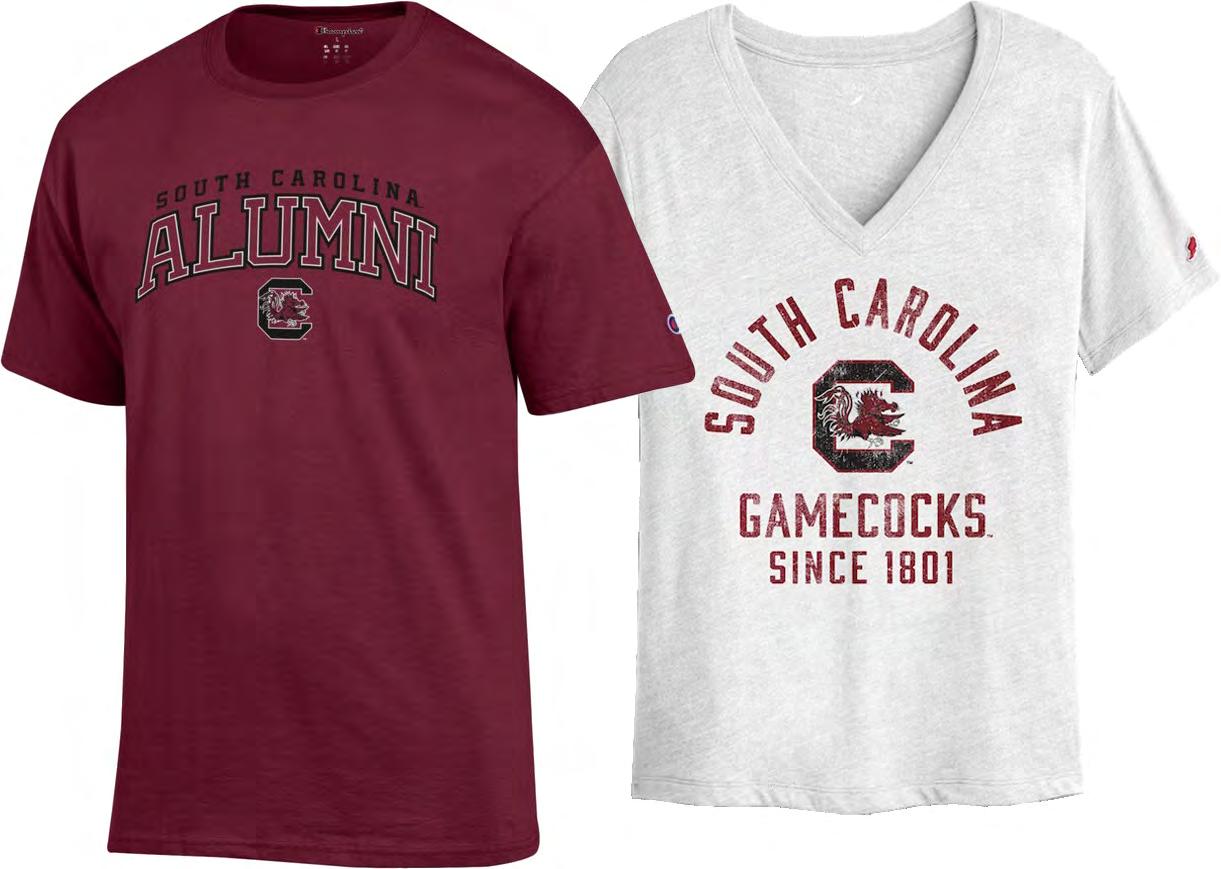
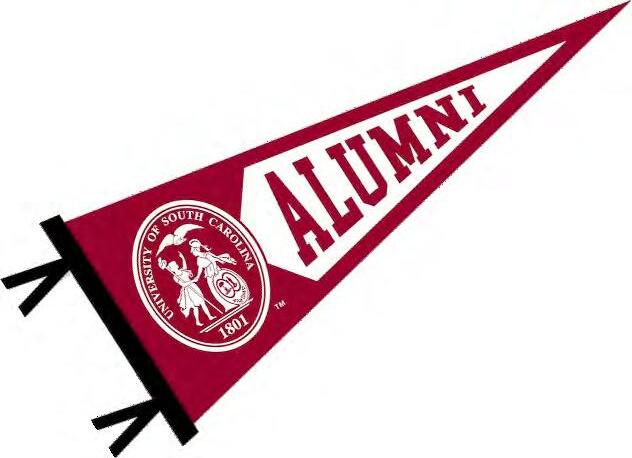


Congratulations Class of 2023! SHOP ALUMNI GEAR IN-STORE OR ONLINE UNIVERSITY OF SOUTH CAROLINA OFFICIAL BOOKSTORE 1400 Greene St, Russell House, Columbia, SC 29208 ShopGamecocks.com





















 Sam Schorr
Sam Schorr


































































































































 Ky Villegas
Ky Villegas















